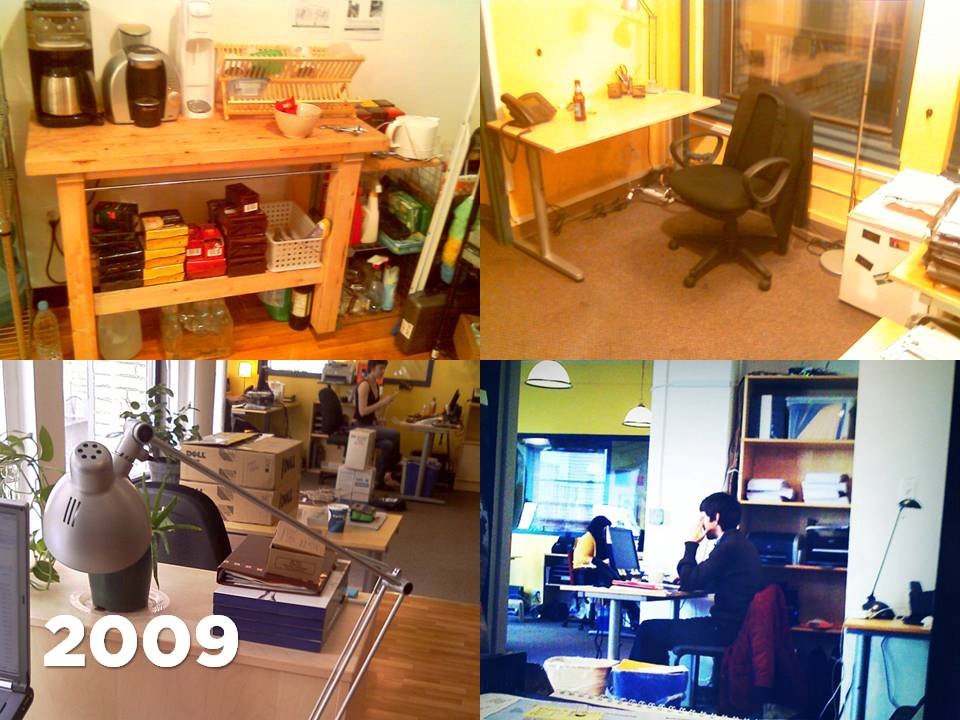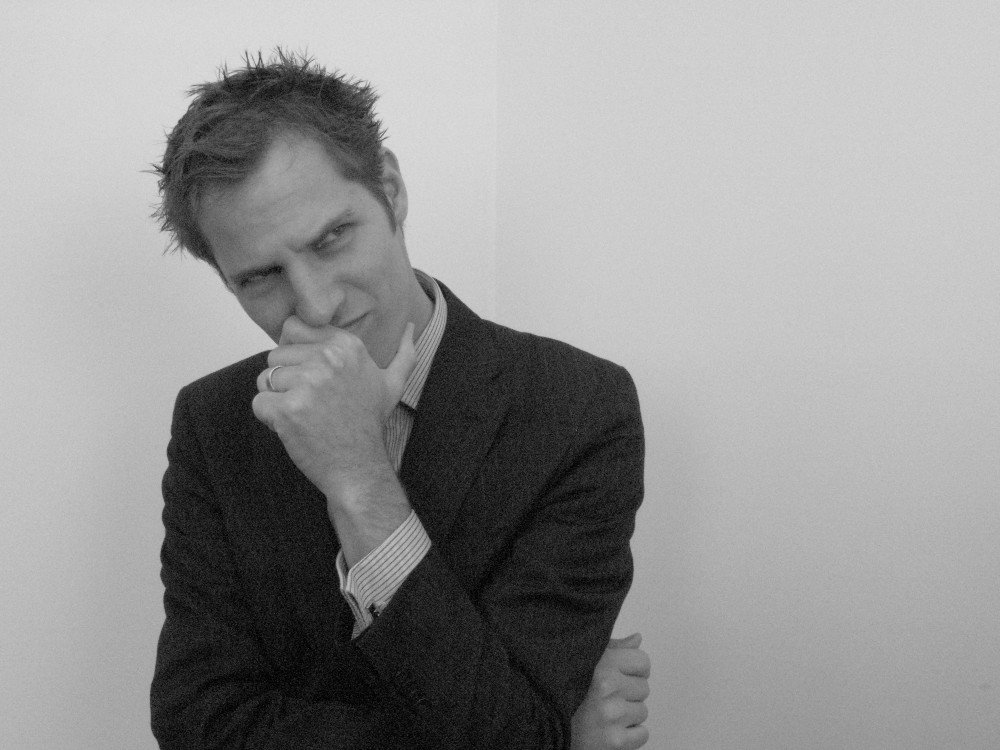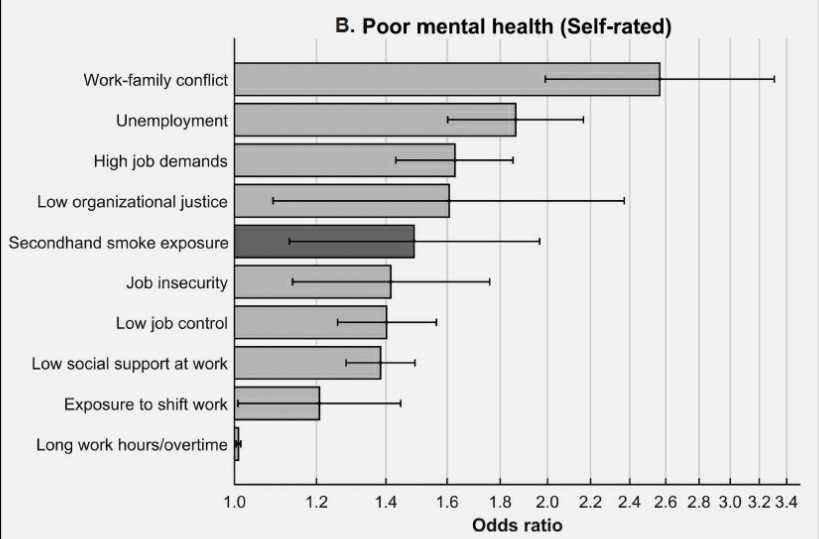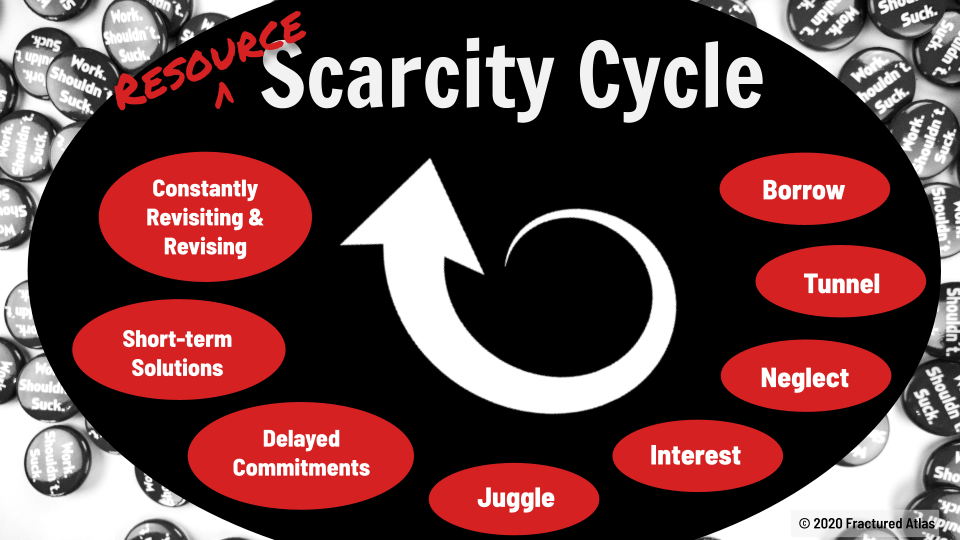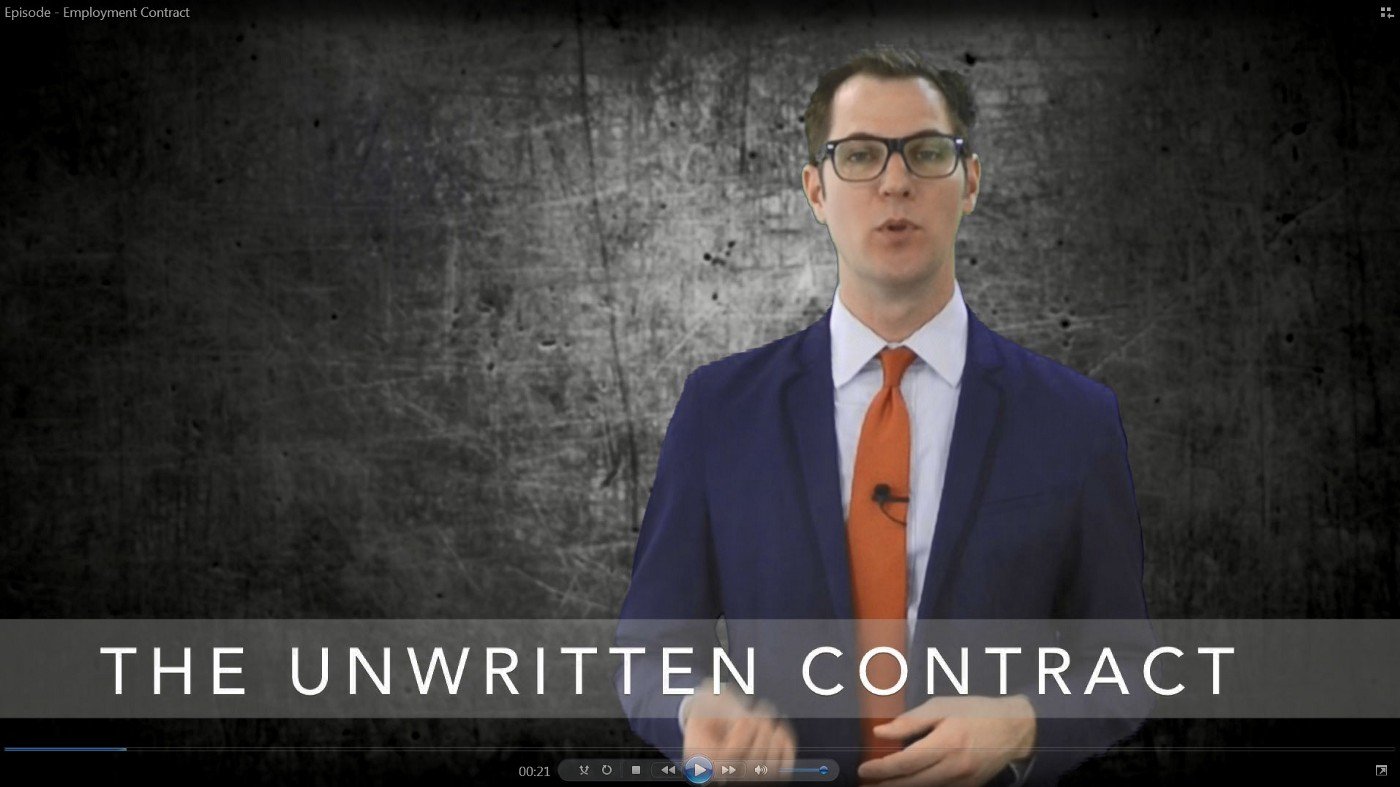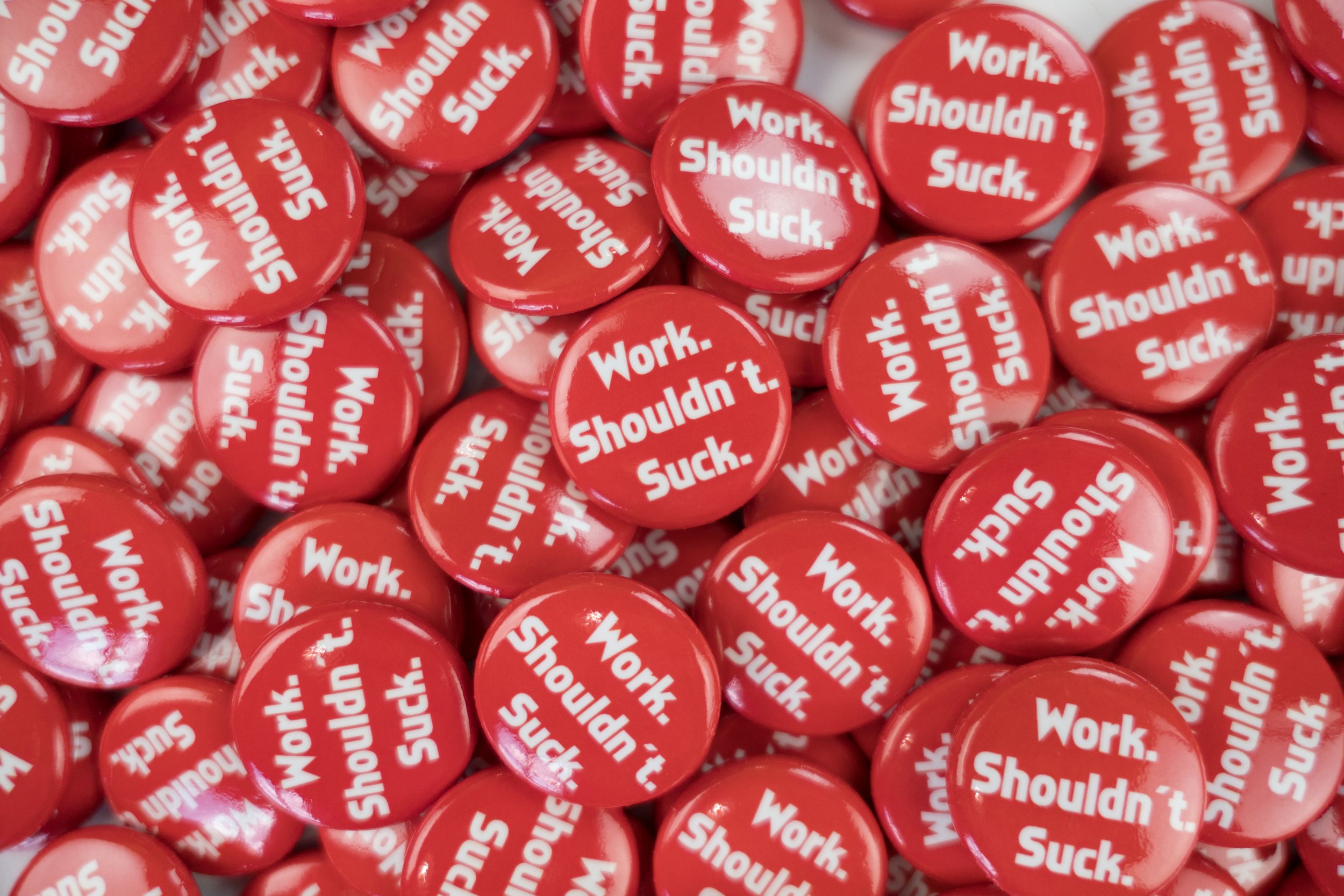
THE BLOG
Assessing a Four Person Non-Hierarchical Leadership Team
The Fractured Atlas leadership team in 2019: Tim Cynova, Lauren Ruffin, Shawn Anderson, Pallavi Sharma
By: Tim Cynova // Published: October 9, 2019
Challenge
How does a Board of Directors (re)craft its annual assessment of the CEO when that role is filled by a four-person, shared, non-hierarchical leadership team? This was precisely the challenge the Fractured Atlas Board faced in early 2019. Below, in detail, we describe the process we crafted to answer this question.
Quick recap
Fractured Atlas has officially been operating with a shared, non-hierarchical leadership team since January 2018. Functionally, we’ve been doing it for about a year longer than that. In advance of Fractured Atlas founder Adam Huttler leaving the organization to become CEO of Exponential Creativity Ventures, staff and board leadership engaged in lengthy conversations about what succession plans might look like. Ultimately, we decided that instead of replacing the CEO “one-for-one,” we would explore a four-person, shared, non-hierarchical leadership team structure. There were multiple reasons why we landed on this model. Here’s more about that decision and how the whole thing works.
The Annual Assessment
One of the core responsibilities for a Board of Directors is to assess the performance of its chief executive. Performance appraisal is an area of HR that even those who do it daily find more art than science. Introduce a volunteer board, who might not possess this specific expertise, further complicate things in that they only engage episodically with its CEO, and you potentially have all the ingredients for potential disaster. Now call it non-hierarchical *shared* leadership among four staff members, and things get quite a bit more complicated. (And to make things more complicated for ourselves at Fractured Atlas, we specifically designed this team structure in a way to avoid a “first among equals” power imbalance.)
With all of this complexity and potential pitfalls at play, it’s one of the reasons why we love our Fractured Atlas board. They, like the staff, relish opportunities to venture into uncharted waters and wrestle with difficult, unusual scenarios. They bring a great deal of wisdom, and perspective, and humility to the table that enables staff and board leadership to truly work in partnership. Because of this, the staff leadership team doesn’t constantly feel like we need to “manage” the board. We’re not spinning information in just the right way to keep the board engaged but, you know, not *too* engaged. It was with this relationship that we set out to design a new shared leadership team assessment.
While we have effectively been operating as a shared leadership team for more than two years now, the *official* one-year anniversary rolled around earlier this year. And with it, the need to assess how well this atypical leadership arrangement was working for us. This prompt lead to multiple conversations between staff and board leadership, and caused us to question the basic premise and purpose of a performance evaluation: how might we can construct one that best suits our needs? What does an assessment for this kind of CEO arrangement look like? Even more fundamental, what’s the purpose and value of a leadership assessment? What’s the value of an annual assessment to the individual staff members? To this team? To the board, other staff, and the organization? How does this track to us fulfilling (or not fulfilling) our organization’s mission and purpose?
We surfaced several key criteria from these discussions:
We wanted to collect voices from around the organization.
We wanted to assess the four people collectively as the CEO function.
We wanted to lay the groundwork for future assessments.
Each of the four individuals on the leadership team oversee an aspect of Fractured Atlas, and they operate as the CEO of sorts for their department (i.e., Programs, Engineering, External Relations, and FinPOps (Finance, People, Operations)). We wanted this assessment structured in a way to evaluate the group as a whole. How well is this group functioning as the CEO of Fractured Atlas? Not the individuals. The leadership team makes decisions of consequence as one entity. It’s not Shawn making this big decision and Lauren making that one. We didn’t want the assessment to be about how well is Tim doing in his job, or Lauren, or Pallavi or Shawn, and then we roll it all up into a team. We wanted it to evaluate the “CEO” as this leadership team configuration. We know from research and experience, that a team can all be comprised of individual “B-level players” but function as an “A-level team.” That’s what should matter to the organization. Similarly there are plenty of examples in life where a collection of A-level players barely manage to function as a C-level team. [Insert your highly-compensated heartbreaking hometown sports team here.]
We settled on a three-pronged approach:
(Part 1) A modified 360-degree review collecting information from board members and from staff who had direct knowledge from working with the leadership team. Ultimately, six staff members and all of our board members were interviewed for roughly 60-minutes each over Zoom video. (For this part, we partnered with the terrific Kelly Kienzle of Open Circle Coaching.)
(Part 2) A way for the leadership team to assess its own team performance. (For this part, we used Patrick Lencioni’s Team Assessment framework.)
(Part 3) A way to capture an explicit professional development component for each of us. For example, in evaluating the four-person team as a single entity, we were omitting individual feedback that would be useful to each person’s professional growth. (For this part, we engaged in a confidential meeting for only the four team members. More on the structure below.)
Part 1: The Modified 360
For the initial assessment of the shared team, we felt it was important for people to weigh in who had direct knowledge of the group and their activities. We wanted people who worked with the team, saw the interactions firsthand, engaged with them in challenging conversations, and who knew the members for longer than just a few months. (In future years, we aspire to simply pull names out of a hat to pick people.)
The objective of conducting these team input interviews was to receive input from colleagues regarding the leadership team model’s areas of strengths, as well as how the model could be improved. Kelly conducted live, confidential interviews to gather suggestions for improvement that would enhance both individual performance and the performance of the team overall. Interviewee input was used to help assess both the effectiveness of this leadership model as well as the leadership team itself.
Her guidance to interviewees included:
Interviews of 60 minutes will be conducted with team members, direct and non-direct reports, and board members. Interviews will be conducted via Zoom video.
All information collected during these interviews will be held confidentially. No direct quotes will be taken and no names will be attributed to any comments.
A minimum of 3 interviewees expressing the same sentiment on a given issue is required to ensure confidentiality and to identify common themes in the feedback.
These common themes will be collected into a Summary Report that will be shared directly with the leadership team, the Board Chair (Russell Willis Taylor) and possibly other Board members.
In advance of the interviews, Kelly worked with the staff and board leadership to craft the following prompts that would be used to guide her conversations:
What are three words you would use to describe the effectiveness of this leadership model?
For what would you hesitate to rely on the leadership team?
What are the greatest collective strengths of the leadership team (not of the individuals)?
What would you prioritize as the leadership team’s greatest opportunities for development?
How could the leadership team foster a better working relationship with you personally or the organization as a whole?
To establish a baseline for the performance of this model: “How effective is this 4-person model in leading the organization as compared to the single CEO model when Adam Huttler was leading Fractured Atlas?”
Following these interviews, Kelly processed the information and compiled it into a 31-page document. That document was delivered to the full board, and discussed during a 90-minute Zoom meeting with the leadership team, Kelly, and board chair.
Part 2: The Team Assessment
The first part of the process collected external perceptions on the leadership team. We now needed a way for the four members of the team to assess our group performance. For this we turned to Patrick Lencioni and his infamous business fable The Five Dysfunctions of a Team.
Lencioni has developed a 38-question assessment that team members complete to rate the group on his five dimensions: Trust, Conflict, Commitment, Accountability, Results. Each question is rated on a 1-to-5 scale of Never, Rarely, Sometimes, Usually, Always. You tally the individual scores at the end and, voila, there’s a numerical value for each component that maps to how well the team feels its doing. The idea is that teams take this on a regular basis (quarterly, semi-annually, etc.) to track how each component is tracking over time. (We complete this assessment on a semi-annual basis.)
Following this assessment, the leadership team met to discuss our reactions. What were the questions and components where we were all in agreement? What questions and components saw the most variety in answers? Why might that be? How might we approach our work in ways that address some of the more challenging aspects we need to improve in our working relationship?
Part 3: Individual Effectiveness
We felt like the first two parts of the assessments gave us great information about how we were working together as a team. However, we were missing a piece of *individual* feedback that typically occurs during one’s annual assessment: (1) here’s where you’re awesome, and (2) here’s where you can be even awesomer. Because of how we structured this overall assessment to focus on the team entity, we were missing an individual professional development aspect. For this component we again turned to Patrick Lencioni.
Each of the four of us answered the two questions below for each of the other three team members. And while we could have reflected on how we’d answers these questions for ourselves, we didn’t include that this time around.
What is [Lauren/Pallavi/Shawn/Tim’s] single most important behavioral quality that contributes to the strength of the team? (That is, their strength.)
What is [Lauren/Pallavi/Shawn/Tim’s] single most important behavioral quality that detracts from the strength of the team? (That is, their weakness or problematic behavior.)
This part of the process was entirely confidential to just the four members of the leadership team. We’ve cultivated a great deal of trust and understanding between us that enables our team to delve into challenging topics. We felt like if someone else joined this meeting (also done entirely on Zoom video), or if the information was shared outside of that circle, we’d potentially “pulling punches” rather than being open and honest, particularly when it came to the things we each needed to work on improving.
Assessment Themes
In Kelly’s 31-page document she highlighted a number of themes from her conversations. Each of the seventeen items below had a page of supporting comments. Some of these findings support our earlier understanding of shared leadership models from research; some we came to discover once we were actually doing the thing; and still others were new themes to contemplate and explore in the coming year.
The model represents and encourages diversity
The model reflects our values and mission
The model is effective and efficient
The model enables us to be bold
The model generates collaboration
Responsibility is shared and that’s good
Responsibility is shared and that’s difficult — Staff’s concerns
Responsibility is shared and that’s difficult — Board’s concerns
Seeking an answer from 4 people is frustrating and slow (but maybe the quality of the answer is better)
Create more transparency in decision-making
Make it easier to approach leaders
This model is exhausting for the leaders
This model is better than single CEO model
This model is potentially better if we address vulnerabilities
Re-imagine how Leadership and Board work together
Establish how the Board will evaluate the leadership
Need to understand why/how these individuals are so successful together
After she delivered her report, the Leadership Team met via Zoom video with both Kelly and Russell Willis Taylor. We discussed the themes and comments, sought clarification in a few areas, and then chatted about what future work to support this topic might look like.
Reflections from an Outside, Independent Party
At the end of her report, Kelly collated a list of recommendations (expressed by the interviewees) on what has made this model effective. She suggested that they might be of interest to other organizations considering a shared leadership model. A number of these align solidly with our previous research into the “how” of creating high-performing shared leadership configurations.
The leadership team must have:
Trust [Kelly’s Note: Understanding how this trust was created on this team is a key question that this entire process sought to answer. This model’s success appears to be fundamentally tied to the trust that exists between these four leaders and/or their individual capacities for trust. The question is whether that trust is a necessary prerequisite or invaluable end-product of using this model. Most likely, it is a fortunate combination of both.]
Collegiality and mutual respect
Comfort with complexity
A leadership assessment of each participant for key leadership qualities
An organization-over-individual ethos
Deep self-awareness
An understanding and acceptance of the flaws of one another
A representation of the organization’s values in the leadership model, while still maintaining equitable recruitment practices
A representation of strong expertise in each relevant content area of an organization
A representation of the fundamental skills of leadership: idea generation, aligning people and execution
Complete buy-in from all participants impacted by the model
A stronger board leadership, and especially Board Chair, than is otherwise required
A norm of non-crisis scenarios, as effective crisis response would be more difficult under this model.
Where to from here
The 2019 assessment process officially closed with a letter from the Board Chair to the Leadership Team. It memorialized this moment, went into the personnel file, and then we moved on. From the annual assessment, and our continued staff/board work, we identified two items specifically mentioned in the assessment to include in future conversations:
How might the Board assist the Leadership Team with the ongoing capacity challenges that they face as leaders of a very lean organization?
How must the Board’s role change in light of the new leadership arrangements to make sure that it contributes real value to Fractured Atlas?
Time will tell how we modify the 2020 assessment process. As with everything at Fractured Atlas, we’re continually iterating and adjusting to best align what we do with what we need. Stay tuned for that recap piece next year.
Tim Cynova is a leader, HR consultant, and educator dedicated to co-creating anti-racist and anti-oppressive workplaces through using human-centered organizational design. He is a certified Senior Professional in HR, trained mediator, principal at Work. Shouldn’t. Suck., on faculty at New York’s The New School and Canada’s Banff Centre for Arts and Creativity, and for the past twelve years served as COO and then Co-CEO of the largest association of artists, creatives, and makers in the U.S.
Working From (Almost) Anywhere: Virtual Realities and a Fully Distributed Workplace
Long exposure image I captured after a productive day of writing in this former one-room school house.
By: Tim Cynova // Published: October 2, 2019
Fractured Atlas “Fun” Fact
Of the eight staff members currently at the Senior Director and C-level tiers, none live and work in the same state (Colorado, Indiana, Maryland, New Jersey, New Mexico, New York, North Carolina, Vermont). And more than half of our Fractured Atlas team now live in 11 U.S. states and 6 countries, with fewer than half spending any time in our sole physical office on 35th Street in New York City.
Why do I mention this here? Because this is all part of our effort to create a thriving workplace — that’s entirely virtual (or distributed) — without any physical office by January 1, 2020. [Note: Our Programs and External Relations teams will be communicating more specifics about how this transition will change some of our processes. Stay tuned.]
We’ve been planning and moving towards this transition for quite some time. Our intrepid board of directors is already there with members living in four countries. Quarterly board meetings take place by Zoom video and see people joining from at least six times zones (with two people usually joining meetings from tomorrow). For our recent meeting, we had members joining at 2AM, 6AM, 8AM, 1PM, 3PM, 5:30PM, and 10PM. (That’s true commitment to an organization when you join a video call at 2AM.)
Fractured Atlas office circa 2009
Vintage Office
The decision to transition to an entirely distributed organization didn’t come out of the blue. Like many organizations, we once had one physical office where every single staff member worked five days a week. We each had our own assigned desk with desktop computer, phone with a cord that plugged into the wall, and a few photos of friends and family. When we had meetings, everyone who needed to attend got up from their desk and walked into our tiny conference room.
Iterate & Adjust
Eventually, we started experimenting with how to structure our work and workplace. “How about one Director-level staff member tries a set work from home day once a week for a few months?” Then we evaluated it. What worked, what didn’t. Iterate and adjust. Then we experimented with two people. Then that became a standard option for Directors (a position that affords more agency in the type of work they do). Then we introduced a computer-based VoIP phone application allowing people to untether from a dedicated desk to take phone calls.
This lead to us experimenting with a work from home (WFH) day for three months with a staff member at the Associate-level (someone who primarily provides customer support for members on phone and through a web-based helpdesk application). Then, we hired our first non-NYC-based employee. Then we increased the number of Associates working from home. Then we acquired and integrated a software development company where no two engineers lived in the same state. Then we switched from desktop computers to laptops, and bought an Ikea couch and comfortable armchairs for the office. Then we hired more non-NYC-based people. This evolved over several years to bring us to where we are today. Until recently, our official WFH policy simply stated “after working with Fractured Atlas for at least a year you can then request a set WFH day.”
Why Do We Do It *That* Way?
The journey towards becoming an entirely distributed organization started several years ago when we ran out of room and chose to renovate our office. During the run up to that renovation, we asked ourselves questions about how we used a physical space, and how that space could be designed to best support the different types of work we needed to accomplish throughout the day.
We asked things like: Why do we use a conference room? What kind of work does that type of space support? What if we didn’t have that space, how would we accomplish those things instead? What kind of environment best supports grant writing? Or talking on the phone assisting our members? How does energy and focus change throughout the day? And what conditions would increase the time we each spent in “flow”?
What does working at Fractured Atlas look and feel like in five years?
We stumbled upon a seemingly simple question that now contributes to our workplace iterating at Fractured Atlas: What do we want working here to look and feel like in five years? Contemplating this question helped us realize the leap we needed to make from maintaining a physical office to being a fully distributed organization. In its simplest form, in five years, working at Fractured Atlas doesn’t look like everyone working in the same physical office circa 2009, and certainty not one in Midtown Manhattan. If anything, the trend over the years for us has been for staff to relocate *away* from NYC rather than towards it.
As we thought about how this workplace vision intersected with our commitments to being an anti-racist and anti-oppressive organization, the transition made even more sense. It affords people rare agency to make decisions about how they want to craft their life in ways that weren’t previously possible. “You live [here] because your job is [here],” no longer would apply.
Specific City Not Required
This vision enables us to hire and retain amazingly talented people who don’t live in the same location. New York City is an expensive place to live. At Fractured Atlas, we anchor our strict fixed tier comp and benefits off of the NYC marketplace, regardless of where people choose to live (i.e., every person at a given tier is paid exactly the same regardless of how long they’ve been in that role at Fractured Atlas and irrespective of whether they live in NYC, Philadelphia, or Dallas). People are welcome to live in NYC, but they can now relocate to, say, Cincinnati, OH and potentially greatly increase their standard of living and purchasing power.
Juggling Multiple Organizational Cultures
Transitioning to entirely distributed would also eliminate a significant silo in our organization: those who work fully virtual versus those who work in HQ. It would go a long way toward “equalizing” that experience in a way that isn’t possible when a significant portion of people work together in a physical office.
How might we work to equalize the experience of working at Fractured Atlas, so everyone feels like they work for the same company rather than different experiences depending on their relationship with a physical office space?
There’s a wealth of research about how virtual work impacts employees. One particularly illuminating piece I read early on in my own journey was “Knowing Where You Stand: Physical Isolation, Perceived Respect, and Organizational Identification Among Virtual Employees.” It was co-written by friend and former Fractured Atlas board member Amy Wrzesniewski, and based on research she and her colleagues conducted. (A selection of other resources, some more anecdotally based and less scientific, are linked at the close of this piece.)
As more Fractured Atlas staff members were working virtually, we wrestled with the question about whether it was possible to “equalize” the experience for those who work fully virtual and those who work solely from HQ. Was it possible to make it feel like everyone worked for the same Fractured Atlas? Especially for those who were hired and then — even though they work closely on a daily basis — might wait upwards of a year before they meet the other members of their distributed team in 3D for the first time.
The more we dove into preparations to transition to a fully distributed organization, the more we realized that we were not trying to maintain only two different organizational cultures — one for those onsite and another for those offsite — we had created, and were trying to manage, at least five different location-related organizational cultures. We had:
(1) Those who worked entirely remote,
(2) Those who worked 5 days a week from the Fractured Atlas office,
(3) Teams where no two members lived or worked in the same location,
(4) Teams where part of the team was remote and part of the team worked from the Fractured Atlas office, and
(5) At least one team where — when factoring in flexible work from anywhere days, travel, vacations and sick days — they seldom had two days with the same HQ/virtual configuration.
That last item in particular exacerbated the stress, uncertainty, and anxiety of a distributed team, because you simply never knew exactly what the configuration would look like from one day to the next. And this feeling permeated at the individual, team, and organizational levels. Moving to an entirely distributed model would at least, in some ways, alleviate this stressor.
Some Staff Are Already There
It’s easy in a change initiative — particularly for those of us who are “losing” an office and our daily routines on 35th Street — to forget that we currently have an organization where more than half of our colleagues already work virtually. More than half of our coworkers have figured out how to do this well and, for them, a transition to being entirely distributed is only likely to improve their work experience.
How might their experience of working for and with Fractured Atlas change for the better? And what can we learn from our colleagues about how they’ve configured home offices and routines to thrive? What can we learn from our coworkers about how to schedule the day? Do people wear shoes when working from home? How do people replicate the positive benefits of those serendipitous in-office chats when it’s just them and maybe their pet? And, most importantly, how do you remember to eat lunch? [Our How We Work, Virtually blog series shares some of those stories.]
With So Much to Do, Why Prioritize This?
At any given time, the Fractured Atlas teams are juggling 3–5 significant, high-priority projects. Most of these focus on developing our products and services to better serve our membership. In some cases though, we focus more internally on how we approach — and can better accomplish — our work and mission.
There are several reasons why our move to be an entirely distributed organization rose to the surface:
Changing Work Patterns. Through our regular operations, we almost by accident ended up with more than half of our team working outside of the New York office. And everyone at Fractured Atlas now works virtually at least one day a week. This leaves an office designed to support 30 people routinely with about 5 occupants on any given day.
Finite Resources & Opportunity Costs. The ten-year lease we signed with terrific terms at the bottom of the real estate market in 2009 is quickly coming up for renewal. With finite resources and associated opportunities costs, every dollar and our related energy spent on maintaining a physical space for fewer and fewer people means we can’t use those resources elsewhere. Even moving to a smaller office still consumes a huge amount of capital and time that could be otherwise dedicated to delivering even better products and services to members, and a better working environment for staff.
Standard of Living & Larger Applicant Pool. In not having to work and live in NYC, Fractured Atlas has access to a huge pool of terrifically talented people who otherwise might not want to live and work in NYC. For those who love their work at Fractured Atlas but no longer want to be in NYC, it means they have the agency to choose where they want to live first. And for those who love NYC? It means many are now gaining upwards of 3 hours a day in discretionary time that previously was spent commuting.
Into the Future! When we reflected on the future of our organization, the culture we wanted to maintain, and how we wanted to create a place where people thrived, having a physical office didn’t rank high on our list of priorities or as a motivator to achieving our goals.
Think of All the Money We Won’t Save
When I mention our move to being an entirely distributed organization, many people respond by saying, “Wow, what a savings! It must be great to get rid of your rent and utilities expense!” In reality, the expense factor was almost an afterthought. (Don’t get me wrong, it was a thought, but not the one that directed us down this path.) While we will likely see some financial savings as a result of this transition, it’s not likely to be as significant as most people assume.
In exchange for rent and utilities, we’ve already incurred higher application subscription fee costs (e.g., Zoom, Dialpad, Slack, Trello). And we’ll incur increased travel and occasional coworking facility costs to address the effects that being physically isolated from coworkers introduces. Our Internet costs will also increase since we’re requiring that staff have high speed Internet connections as a work condition, and thus will be reimbursed for that monthly expense. (There are only so many video and audio calls you can do with spotty service before your coworkers and customers lose patience.)
You’ll likely be disappointed if money is the primary motivator to make this change. With any change initiative, the stronger and more substantive the underlying purpose for the change, the more ballast you have to steady the ship when it’s being tossed about on the sea of change. Why are we doing this thing? To save money — [cue sad trombone sound] — won’t inspire much. While wise resource allocation is important, it’s not usually a solid enough reason to get people to jump out of bed in the morning. Again, it’s not that it doesn’t have merit, but I bet you can drill down to a more purpose-driven answer than “save money.” For us, it’s about continuing to craft a workplace where people can thrive, and one that enables us to better serve our members. And *that’s* why we went about making the change.
Younger me, skeptical of Work From Anywhere arrangements.
I Haven’t Always Been a Fan
Over my decade at Fractured Atlas, I’ve seen us grow from a handful of people to nearly 40. I was part of the group that moved us, box by box, into our current office space that afforded us, at the time, *way* more space than we needed. I was there when we renovated it because we had too few places to work in an always-packed office. And I’m here now, almost as it was in 2009, with just a handful of people in a way too empty space. It’s beautiful and convenient and has colleagues in 3D that I thoroughly enjoy working with.
But lest you think I’ve always been a Work From Anywhere (WFA) evangelist, for many years I feared that in us being more virtual we’d lose the soul of what it meant to be Fractured Atlas. We’d drain the culture that made us, well, us.
Worried that more people working remote will change the company culture? For us, it did. It also allowed us to hire incredible people we otherwise wouldn’t have been able to work with. It introduced flexibility with how and when people do work so that they had more agency in their life. And, maybe most importantly, it has allowed us to serve our members in more and different ways.
What I realized a few years back was, just as I’m no less me than I was 25 years ago, I’m me, but different. Same with you. If we look at humans on a cellular level, over 25 years, most of the cells in our bodies have been replaced. But somehow, we’re still us. Organizations are similar. When I was afraid of us losing our organizational culture, I didn’t consider the culture we were building as a direct result of our organizational culture. The thing we were building was the thing we were building because of the thing we built. (Yep, I know, slightly convoluted, but thanks for staying with me there.) The DNA-level stuff about Fractured Atlas was still there, but now with increased resiliency and flexibility and adaptability as we cultivated a place where we didn’t all physically work in the same space.
Experiment, iterate, and be purposeful about the kinds of things you can do in a space. Also, don’t forget to be a human.
Crafting Your Own Experiment
Like much of what each one of us does in life, someone has figured out how to solve it, somewhere. It’s the proverbial “solved problem.” Part of our iterative and creative process at Fractured Atlas leverages those learnings. (It’s why we’re constantly reading, listening, and looking across sectors for case studies, different perspectives, and solutions.) And then we, in turn, feel a responsibility to give back by sharing what works and doesn’t work in our own approaches. There are 7 *billion* of us on this Earth learning and doing. Let’s not recreate the wheel if it’s not necessary.
When it comes to alternative work arrangements, you certainly don’t need to give up your office entirely to ask: What do we want work to look and feel like here in five years? With those answers in mind though, begin to experiment. Here’s what’s comforting to me about this: plenty of people have come before us and have figured out ways to address even the most complicated of these issues. We get to leverage those learnings to create an environment that fits us and our organization best and how we want to work.
If you’re not sure where to start, here’s a quick list of some helpful places to get you going:
Tools to Try
Even if you’re not convinced that people should work outside of your office, you can start to experiment and iterate with tools to improve workplace communication, transparency, and productivity.
Introducing communication tools like Slack or Flowdock will eliminate countless email threads when all you need to do is have a quick chat between a few people. Use a Zoom video for meeting the next time you’re trying to coordinate a meeting with someone offsite. (Think that “quick chat over a cup of coffee.”) Learning how to facilitate and participate in a video conference call is a professional skill people need to develop, just like the proper format for a business letter.
Try using a whiteboarding tool likely Mural to replace everyone standing by a physical board. Being intentional about using a tool like Mural has the added benefit of keeping you focused on the task at hand and often eliminates side conversations that take you off track or burn valuable time. Track projects and priorities in tools like Trello. (Pro tip: We use it to compile and manage meeting agendas, and then track our action items.)
Then there are frameworks like OKRs to create transparency, alignment, and accountability around the work that everyone is doing. Objectives and Key Results (or OKRs) are a huge asset when incorporating work from anywhere arrangements. They help build the trust necessary for high performing teams. Now I don’t need to physically see you “working” in an office to know that you’re making progress on our previously discussed and approved projects. Whatever you choose, just start experimenting and iterating.
Where Does This Leave Us
What will it look and feel like to work at Fractured Atlas in five years? I’m not entirely sure. I’d be lying if I said that I had a clear idea. What I do know is that we have a sense for what it might look like and are making directionally-correct iterations towards that goal. In the end, the important part here is making sure that what we do today sets up Fractured Atlas of the future with the things it will need to be successful in service to our mission then.
On a practical front, we continue to work through Project Blue Whale (as our coworker Nicola has dubbed this in the plan outlining each stage of this transition). Each day brings new, fun questions to wrestle with. How and where do we receive mail? How do we deposit checks, and cut checks? What’s our corporate address for tax forms when we don’t have an office? How do we get three “wet” signatures on this form when everyone lives in a different country? How often and where do we meet coworkers in 3D? Where do we store spare equipment like laptops?
However we end up answering these questions, it will be done intentionally as we work towards a future of Fractured Atlas that best supports our coworkers, mission, and members.
Tim Cynova is a leader, HR consultant, and educator dedicated to co-creating anti-racist and anti-oppressive workplaces through using human-centered organizational design. He is a certified Senior Professional in HR, trained mediator, principal at Work. Shouldn’t. Suck., on faculty at New York’s The New School and Canada’s Banff Centre for Arts and Creativity, and for the past twelve years served as COO and then Co-CEO of the largest association of artists, creatives, and makers in the U.S.
Bring Your Whole(ish) Self to Work
By: Tim Cynova // Published: March 29, 2019
Remember when it seemed like everyone was trying to achieve “work-life” balance? More recently, perhaps in a nod to the challenges of balancing “work” and “life” in an always-connected world, or maybe because for those searching for meaning and purpose in their activities there’s not always a bright line distinction between “work” and “life,” the phrase has shifted to “bringing our whole selves to work.”
Well, with my HR hat on, it’s typically people who bring their whole selves to work who are the ones the HR folks need to have meetings with, or about. So, I’d like to propose a slight reframing: let’s aim to bring our whole(ish) selves to work. 85% of ourselves is probably just about the right calibration.
Why 85%?
In the end, not even our closest friends and family *really* want us to bring 100% of ourselves to our interactions. Yes, be present, genuine, and authentic. But no to bringing every single piece of us into the space. When we do bring 100% of ourselves into a space, how might that actually make it more challenging for others to show up more fully themselves?
Not scientific.
I’ll bet most people don’t exceed the 50% mark though. For many, it’s less about how to dial back from 100% and more about what conditions would be necessary to bring a little (or a lot) more of themselves.
Looking at this through the lens of building high-performing teams — where people can thrive — we can see even clearer why aiming for everyone to move towards 85% might be the better pursuit.
Psychological Safety & Diversity in Teams
Research shows that two traits of high-performing teams are psychological safety — the ability for people to participate without fear of retribution (the ol’ getting your legs kicked out from under you when you say something the boss doesn’t agree with) — and that teams are diverse in as many ways as possible. Both of these play significantly into people feeling comfortable bringing more of themselves to work.
Here’s just a sampling of the ways diversity can show up in our organizations: sex, gender, age, race, religion, national origin, ethnicity, disability, sexuality, income, learning modalities, education, culture, customs, life or prior work experiences, networks, style, speech, lineage, origins, political beliefs, appearance, and work styles (just to name a few).
Thinking about where people calibrate themselves with regards to that 85%, I imagine in U.S. corporate culture, aside for a number of heterosexual, White, cis-gender men in positions of power (or perceived power), many others feel a struggle of varying levels to bring their wholes selves to work, and/or are conflicted about what and how much they want to bring of themselves. This creates a drag on people’s ability to be authentic, do their best work, and thrive. And the sad fact here is that while we’re talking about bringing our whole selves to work, some of our colleagues are likely comfortable bringing only about 20% of themselves to their work.
How much richer and more meaningful would our organizations be if everyone felt comfortable bringing 85% of themselves to work?
How much more meaningful and engaged might someone be if they felt they could go from bringing 20% of themselves to, say, 60%? How might this result in more of us being able to fulfill our organizational missions and our personal search for purpose?
As we work to build more inclusive, diverse, and/or equitable teams and organizations, it’s incumbent upon those of us in positions of leadership — wherever we lead from in our organizations — to do whatever we can to assist in creating an environment that’s supportive of everyone bringing more of themselves to their work (and pointing out for those few people who might need to dial it back, when that’s appropriate too).
Why is this important?
First, because it’s the morally right thing to do. If leaders aren’t continually trying to make progress in supporting those who work for their organizations, they are failing at a core leadership responsibility. However, if we can’t agree there, let’s move more to the business case.
I’ve written about how research shows the vast majority of people who work at our organizations are disengaged from their work, and that more than half are looking for new jobs. (Quick recap: Gallup Worker Engagement Index found that roughly 85% of employees are disengaged and 51% of employees are looking for another job.) Recent research adds to that to show that disengagement and satisfaction in work — and the ability to “bring one’s whole self to work” — disproportionately, negatively impacts our colleagues of color.
In one study, researchers found that 38% of our Black colleagues feel it’s never appropriate in the workplace to talk about the bias they experience in life. This makes them twice as likely as those not in this group to experience feelings of isolation, three times as likely to have one foot out the door and be looking for another job, and 13 times as likely to be disengaged in their work.
And this is just as it relates to our colleagues of color. I’m confident that if we looked at findings as they related to other aspects of diversity we’d find similar disheartening results.
The Lovingkindness Lens
I’ve been meditating for a few years now. For those fellow meditators, you’ll be familiar with the Lovingkindness, or metta, meditation. For those less familiar, it basically goes like this: you meditate on phrases like, “May you be safe, be happy, be healthy, live with ease, live with joy,” while focusing first on yourself; then focusing on someone close to you. Next, you focus on someone you know but don’t really know (think of the Starbucks barista you see each morning). Then, you move to someone who really challenges you; and finally, to all beings everywhere.
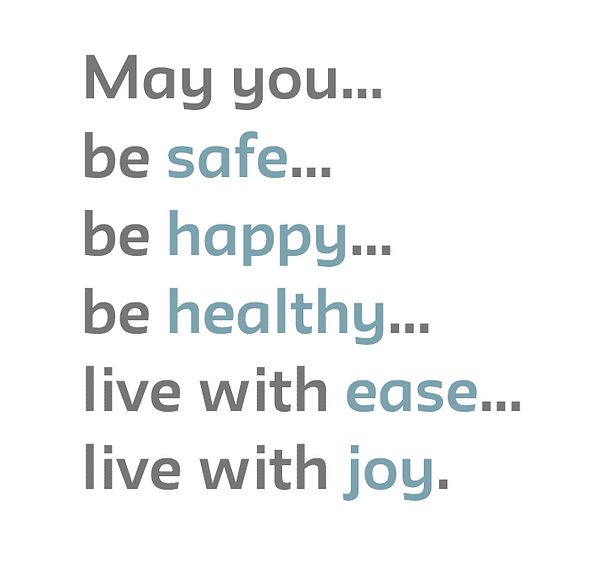
When I was meditating on these phrases a few months back, I had an epiphany. The Lovingkindness meditation provides an excellent lens to use when seeking to identify blockers for bringing more of oneself to work.
It works like this: how safe is your workplace? Not necessarily physical safety (although that certainly might be part of it) but psychologically safety. How happy are you and your coworkers? How easy is it for you to do your work? Easy as in it doesn’t feel like people keep throwing obstacles in your way at every turn, not that your work isn’t challenging in a good way.
As I meditated on this, I was struck by one of the greatest ironies of the cultural sector. Our sector exists, in large, part to make the world a better, more beautiful and understanding place. And sadly — both anecdotally and backed by research — most people are unfulfilled (and some are downright miserable) doing the work. At what cost are we trying to achieve our charitable missions if we do it by blowing through and burning out our people?
At what cost are we trying to achieve our charitable missions if we do it by blowing through and burning out our people?
When we use Lovingkindness’s “healthy” lens here the shit gets real, fast. How many hours are people working? (And how much work is supposed to be accomplished during that period?) How many people don’t feel like they can step away from their desks for lunch? How many people feel like they can’t take more than a few vacation days a year? And when they do get away, they feel pressure — real or implied — to stay connected to email and voicemails.
Next, let’s use the “work with ease” lens. Again, this doesn’t mean work is easy, it’s that it doesn’t always feel like you’re pushing an ever-larger boulder up an increasingly steep mountain. “All I want to do is send out the annual appeal letters. Why does it feel like I’m participating in some Tough Mudder competition?!” And lastly, does your work bring you joy? If you personally can’t positively answer *that* question, again, I ask at what cost are we doing this work? Life is simply too short.
Some might find it helpful to plot their current positions on a Lovingkindness chart like the one above.
Let’s then ask ourselves, when reflecting on safety, happiness, health, ease, and joy in our workplace, how many of our coworkers can honestly say yes to those things? Is it just the executive director? Or, oh God, maybe not even the executive director. We might not like the results, but burying our head in the sand doesn’t mean that it’s not true. I can’t think of an organization that can check off all of these for every single person. However, (1) that’s no excuse for us not to continually be doing something about it, and (2) this Lovingkindness lens gives us a quick “balance sheet” or snapshot to start using. This snapshot highlights the often amorphous “organizational culture” components so we can pull them apart and begin identifying ways to address them.
The Lovingkindess Lens in Action
The beauty of using the Lovingkindness lens is that it can be applied at the individual, team, and organizational levels. Ask yourself first, do I feel safe in my work and workplace? Why or why not? What does safety at work look and feel like? What would help me to feel safer? Then, am I happy in my work? What would need to change for me to find daily happiness and joy in my work? What part of my work always feels like an unnecessary struggle? (At this point, you might find a job crafting exercise to be quite helpful.)
Sometimes, to bring our whole(ish) selves to work, we need a little help from our friends and colleagues.
Then, take it the next step and ask, who on my team or in my organization might not feel safe? Who might not be happy in their work? Then, before running to them as saying — “Hey, why don’t you feel safe to bring more of yourself to work?” — interrogate your assumptions. Why do you think that? What gives you that impression? If someone doesn’t feel psychologically safe at work, they’re probably not going to give you an honest answer to that question anyways. There likely is work that needs to be done in the organization before you will see progress here. (For more on building psychologically safe workplaces, check out the awesome work by Amy C. Edmondson.)
And lastly, expand this beyond people on staff to consider your board, your volunteers, and those you’re trying to serve. First, how engaged are they in the work? Are they happy with us? Do we help those we serve to be healthy? How easy is it for people to participate in our work? You will likely need to take a few liberties to map these lenses to your organization, but going down the list to articulate “What does safety look like for those we serve?” “How might what we do make it easier for people?” is a helpful starting place.
What can I do right now to move towards what I really want?
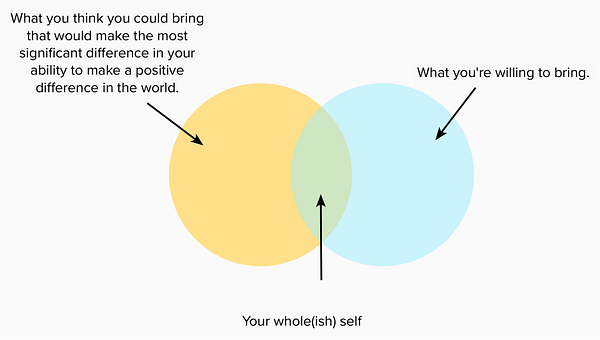
As we think about the 85% we aim to bring, about safety, happiness, health, ease, and joy — how do we decide what we’re comfortable bringing into a space? And how do we actually do it? Meditating on what to bring will surface things that are personal and bespoke to each of us. We’ll likely discover there’s a Venn diagram of sorts with two components: What you think you could bring that would make the most significant difference in your ability to make a positive difference in the world, and What you’re willing to bring.
We have but one pass at this life. If we’re doing it while overly throttling who we are as humans, to the detriment of ourselves, our ability to achieve our potential and make our dent in the universe, at what cost is this to us truly living? Showing up more fully — especially when it doesn’t inhibit someone else’s humanity — should be a goal we all feel that we can strive towards.
Tim Cynova is an HR and org design consultant, an educator, and podcaster dedicated to dusting off workplaces to (re)center values-based approaches where more people can thrive. He is a certified Senior Professional in HR (SPHR), trained mediator, principal at WSS HR LABS, on faculty at New York’s The New School, Minneapolis College of Art & Design, and Hollyhock Leadership Institute. He has held executive leadership roles in a variety of nonprofits for the better part of the last 20 years, and is also an avid coffee drinker.
Summer Reading Challenge 2019
Note: The librarian’s last name is Reading. How awesome is that?! (Also note, my mom saved everything.)
By: Tim Cynova // Published: May 24, 2019
Around Memorial Day each year when my sister and I were kids, our parents would take us to the McCollough Branch of the Evansville Public Library. It was that annual rite of passage — the summer reading challenge! We’d select a hefty stack of books, and then hope to God come Labor Day we’d have read enough of them to earn that sweet certificate for a free scoop of Baskin Robbins ice cream.
In the spirit of those early ‘80s summer reading challenges, I’ve pulled together what’s currently on my reading list for the summer. And, if I can complete just four of these books come Labor Day, you better believe I’m headed to Baskin Robbins, or Shake Shack, whichever is closest.
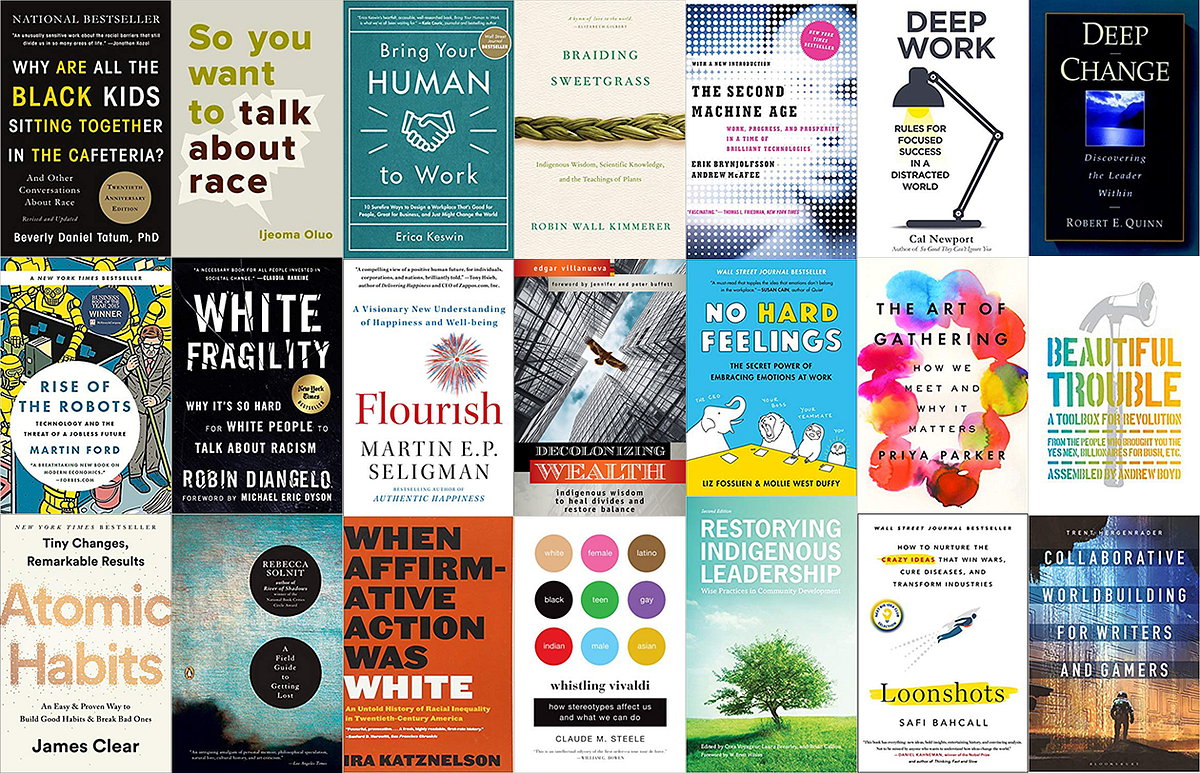

Braiding Sweetgrass: Indigenous Wisdom, Scientific Knowledge and the Teachings of Plants
by Robin Wall Kimmerer
Drawing on her life as an indigenous scientist, and as a woman, Kimmerer shows how other living beings―asters and goldenrod, strawberries and squash, salamanders, algae, and sweetgrass―offer us gifts and lessons, even if we’ve forgotten how to hear their voices. In reflections that range from the creation of Turtle Island to the forces that threaten its flourishing today, she circles toward a central argument: that the awakening of ecological consciousness requires the acknowledgment and celebration of our reciprocal relationship with the rest of the living world. For only when we can hear the languages of other beings will we be capable of understanding the generosity of the earth, and learn to give our own gifts in return.
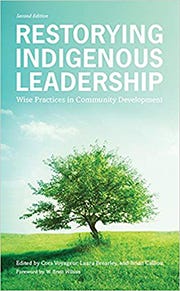
Restorying Indigenous Leadership: Wise Practices in Community Development
by Cora Voyageur, Laura Brearley, and Brian Calliou
Restorying Indigenous Leadership: Wise Practices in Community Development is a foundational resource of the most recent scholarship on Indigenous leadership. The authors in this anthology share their research through nonfictional narratives, innovative approaches to Indigenous community leadership, and inspiring accounts of success, presenting many models for Indigenous leader development. These engaging stories are followed by a Wise Practices section featuring seven significant contemporary case study summaries. Restorying promotes hope for the future, individual agency, and knowledge of successful community economic development based upon community assets. It is a diverse collection of iterative and future-oriented ways to achieve community growth that acknowledges the centrality of Indigenous culture and identity.

Decolonizing Wealth: Indigenous Wisdom to Heal Divides and Restore Balance
by Edgar Villanueva
Decolonizing Wealth is a provocative analysis of the dysfunctional colonial dynamics at play in philanthropy and finance. Award-winning philanthropy executive Edgar Villanueva draws from the traditions from the Native way to prescribe the medicine for restoring balance and healing our divides.
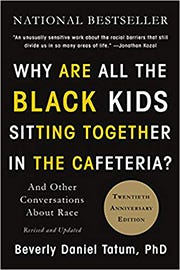
Why Are All the Black Kids Sitting Together in the Cafeteria?: And Other Conversations About Race
by Beverly Daniel Tatum
Walk into any racially mixed high school and you will see Black, White, and Latino youth clustered in their own groups. Is this self-segregation a problem to address or a coping strategy? Beverly Daniel Tatum, a renowned authority on the psychology of racism, argues that straight talk about our racial identities is essential if we are serious about enabling communication across racial and ethnic divides. These topics have only become more urgent as the national conversation about race is increasingly acrimonious. This fully revised edition is essential reading for anyone seeking to understand the dynamics of race in America.
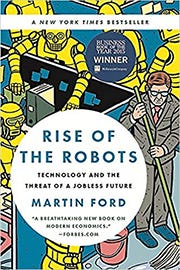
Rise of the Robots: Technology and the Threat of a Jobless Future
by Martin Ford
What are the jobs of the future? How many will there be? And who will have them? As technology continues to accelerate and machines begin taking care of themselves, fewer people will be necessary. Artificial intelligence is already well on its way to making “good jobs” obsolete: many paralegals, journalists, office workers, and even computer programmers are poised to be replaced by robots and smart software. As progress continues, blue and white collar jobs alike will evaporate, squeezing working- and middle-class families ever further. At the same time, households are under assault from exploding costs, especially from the two major industries- education and health care- that, so far, have not been transformed by information technology. The result could well be massive unemployment and inequality as well as the implosion of the consumer economy itself. The past solutions to technological disruption, especially more training and education, aren’t going to work. We must decide, now, whether the future will see broad-based prosperity or catastrophic levels of inequality and economic insecurity. Rise of the Robots is essential reading to understand what accelerating technology means for our economic prospects- not to mention those of our children- as well as for society as a whole.

So You Want to Talk About Race
by Ijeoma Oluo
Ijeoma Oluo offers a hard-hitting but user-friendly examination of race in America. Widespread reporting on aspects of white supremacy — from police brutality to the mass incarceration of African Americans — have made it impossible to ignore the issue of race. Still, it is a difficult subject to talk about. How do you tell your roommate her jokes are racist? Why did your sister-in-law take umbrage when you asked to touch her hair — and how do you make it right? How do you explain white privilege to your white, privileged friend? In So You Want to Talk About Race, Ijeoma Oluo guides readers of all races through subjects ranging from intersectionality and affirmative action to “model minorities” in an attempt to make the seemingly impossible possible: honest conversations about race and racism, and how they infect almost every aspect of American life.

Deep Work: Rules for Focused Success in a Distracted World
by Cal Newport
Deep work is the ability to focus without distraction on a cognitively demanding task. It’s a skill that allows you to quickly master complicated information and produce better results in less time. Deep work will make you better at what you do and provide the sense of true fulfillment that comes from craftsmanship. In short, deep work is like a super power in our increasingly competitive twenty-first century economy. And yet, most people have lost the ability to go deep-spending their days instead in a frantic blur of e-mail and social media, not even realizing there’s a better way. A mix of cultural criticism and actionable advice, Deep Work takes the reader on a journey through memorable stories and no-nonsense advice, such as the claim that most serious professionals should quit social media and that you should practice being bored.
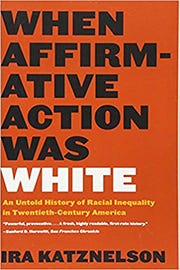
When Affirmative Action Was White: An Untold History of Racial Inequality in Twentieth-Century America
by Ira Katznelson
Ira Katznelson fundamentally recasts our understanding of twentieth-century American history and demonstrates that all the key programs passed during the New Deal and Fair Deal era of the 1930s and 1940s were created in a deeply discriminatory manner. Through mechanisms designed by Southern Democrats that specifically excluded maids and farm workers, the gap between black and white people actually widened despite postwar prosperity. In the words of noted historian Eric Foner, “Katznelson’s incisive book should change the terms of debate about affirmative action, and about the last seventy years of American history.”
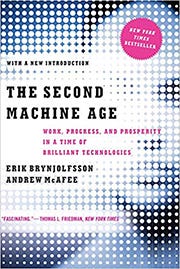
The Second Machine Age: Work, Progress, and Prosperity in a Time of Brilliant Technologies
by Erik Brynjolfsson and Andrew McAfee
In The Second Machine Age MIT’s Erik Brynjolfsson and Andrew McAfee reveal the forces driving the reinvention of our lives and our economy. As the full impact of digital technologies is felt, we will realize immense bounty in the form of dazzling personal technology, advanced infrastructure, and near-boundless access to the cultural items that enrich our lives. Amid this bounty will also be wrenching change. Professions of all kinds―from lawyers to truck drivers―will be forever upended. Companies will be forced to transform or die. Recent economic indicators reflect this shift: fewer people are working, and wages are falling even as productivity and profits soar. Drawing on years of research and up-to-the-minute trends, Brynjolfsson and McAfee identify the best strategies for survival and offer a new path to prosperity.

A Field Guide to Getting Lost
by Rebecca Solnit
Written as a series of autobiographical essays, A Field Guide to Getting Lost draws on emblematic moments and relationships in Rebecca Solnit’s life to explore issues of uncertainty, trust, loss, memory, desire, and place. Solnit is interested in the stories we use to navigate our way through the world, and the places we traverse, from wilderness to cities, in finding ourselves, or losing ourselves. While deeply personal, her own stories link up to larger stories, from captivity narratives of early Americans to the use of the color blue in Renaissance painting, not to mention encounters with tortoises, monks, punk rockers, mountains, deserts, and the movie Vertigo. The result is a distinctive, stimulating voyage of discovery.

No Hard Feelings: The Secret Power of Embracing Emotions at Work
by Liz Fosslien and Mollie West Duffy
The modern workplace can be an emotional minefield, filled with confusing power structures and unwritten rules. We’re expected to be authentic, but not too authentic. Professional, but not stiff. Friendly, but not an oversharer. Easier said than done! As both organizational consultants and regular people, we know what it’s like to experience uncomfortable emotions at work — everything from mild jealousy and insecurity to panic and rage. Ignoring or suppressing what you feel hurts your health and productivity — but so does letting your emotions run wild. Our goal in this book is to teach you how to figure out which emotions to toss, which to keep to yourself, and which to express in order to be both happier and more effective.

Loonshots: How to Nurture the Crazy Ideas That Win Wars, Cure Diseases, and Transform Industries
by Safi Bahcall
Loonshots reveals a surprising new way of thinking about the mysteries of group behavior that challenges everything we thought we knew about nurturing radical breakthroughs. Drawing on the science of “phase transitions,” Bahcall shows why teams, companies, or any group with a mission will suddenly change from embracing wild new ideas to rigidly rejecting them. Using examples that range from the spread of fires in forests to the hunt for terrorists online, and stories of thieves and geniuses and kings, Bahcall shows how this new kind of science helps us understand the behavior of companies and the fate of empires. Loonshots distills these insights into lessons for creatives, entrepreneurs, and visionaries everywhere.

Whistling Vivaldi: How Stereotypes Affect Us and What We Can Do
by Claude M. Steele
Claude Steele shares the experiments and studies that show, again and again, that exposing subjects to stereotypes impairs their performance in the area affected by the stereotype. Steele’s conclusions shed new light on a host of American social phenomena, from the racial and gender gaps in standardized test scores to the belief in the superior athletic prowess of black men. Steele explicates the dilemmas that arise in every American’s life around issues of identity, from the white student whose grades drop steadily in his African American Studies class to the female engineering students deciding whether or not to attend predominantly male professional conferences. Whistling Vivaldi offers insight into how we form our senses of identity and ultimately lays out a plan for mitigating the negative effects of “stereotype threat” and reshaping American identities.
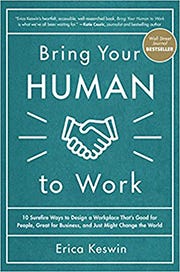
Bring Your Human to Work: 10 Surefire Ways to Design a Workplace That Is Good for People, Great for Business, and Just Might Change the World
by Erica Keswin
As human beings, we are built to connect and form relationships. So, it should be no surprise that relationships must also translate into the workplace, where we spend most of our time. Companies that recognize this will retain the most productive, creative, and loyal employees, and invariably seize the competitive edge. The most successful leaders are those who actively form quality relationships with their employees, who honor fundamental human qualities―authenticity, openness, and basic politeness―and apply them day in and day out. Paying attention and genuinely caring about the effects people have on one another other is key to developing a winning culture where people perform at the top of their game and want to work.
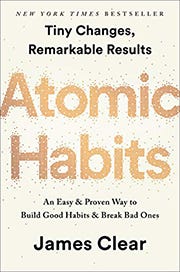
Atomic Habits: An Easy & Proven Way to Build Good Habits & Break Bad Ones
by James Clear
Atomic Habits offers a proven framework for improving and will teach you exactly how to form good habits, break bad ones, and master the tiny behaviors that lead to remarkable results. Atomic Habits will reshape the way you think about progress and success, and give you the tools and strategies you need to transform your habits — whether you are a team looking to win a championship, an organization hoping to redefine an industry, or simply an individual who wishes to quit smoking, lose weight, reduce stress, or achieve any other goal.
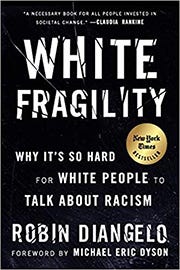
White Fragility: Why It’s So Hard for White People to Talk About Racism
by Robin DiAngelo
In this “vital, necessary, and beautiful book” (Michael Eric Dyson), antiracist educator Robin DiAngelo deftly illuminates the phenomenon of white fragility and “allows us to understand racism as a practice not restricted to ‘bad people’ (Claudia Rankine). Referring to the defensive moves that white people make when challenged racially, white fragility is characterized by emotions such as anger, fear, and guilt, and by behaviors including argumentation and silence. These behaviors, in turn, function to reinstate white racial equilibrium and prevent any meaningful cross-racial dialogue. In this in-depth exploration, DiAngelo examines how white fragility develops, how it protects racial inequality, and what we can do to engage more constructively.
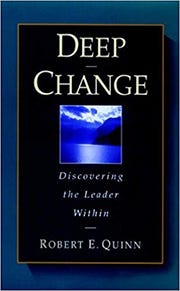
Deep Change: Discovering the Leader Within
by Robert E. Quinn
Don’t let your company kill you! Open this book at your own risk. It contains ideas that may lead to a profound self-awakening. An introspective journey for those in the trenches of today’s modern organizations, Deep Change is a survival manual for finding our own internal leadership power. By helping us learn new ways of thinking and behaving, it shows how we can transform ourselves from victims to powerful agents of change. And for anyone who yearns to be an internally driven leader, to motivate the people around them, and return to a satisfying work life, Deep Change holds the key.

Beautiful Trouble: A Toolbox for Revolution
by Andrew Boyd and Dave Oswald Mitchell
Beautiful Trouble brings together dozens of seasoned artists and activists from around the world to distill their best practices into a toolbox for creative action. Sophisticated enough for veteran activists, accessible enough for newbies, this compendium of troublemaking wisdom is a must-have for aspiring changemakers. Showcasing the synergies between artistic imagination and shrewd political strategy, Beautiful Trouble is for everyone who longs for a more beautiful, more just, more livable world — and wants to know how to get there.

Collaborative Worldbuilding for Writers and Gamers
by Trent Hergenrader
The digital technologies of the 21st century are reshaping how we experience storytelling. More than ever before, storylines from the world’s most popular narratives cross from the pages of books to the movie theatre, to our television screens and in comic books series. Plots intersect and intertwine, allowing audiences many different entry points to the narratives. In this sometimes bewildering array of stories across media, one thing binds them together: their large-scale fictional world. Collaborative Worldbuilding for Writers and Gamers describes how writers can co-create vast worlds for use as common settings for their own stories. Using the worlds of Star Wars, Lord of the Rings, A Game of Thrones, and Dungeons & Dragons as models, this book guides readers through a step-by-step process of building sprawling fictional worlds complete with competing social forces that have complex histories and yet are always evolving. It also shows readers how to populate a catalog with hundreds of unique people, places, and things that grow organically from their world, which become a rich repository of story making potential.
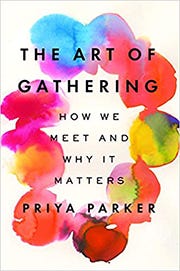
The Art of Gathering: How We Meet and Why It Matters
by Priya Parker
In The Art of Gathering, Priya Parker argues that the gatherings in our lives are lackluster and unproductive — which they don’t have to be. We rely too much on routine and the conventions of gatherings when we should focus on distinctiveness and the people involved. At a time when coming together is more important than ever, Parker sets forth a human-centered approach to gathering that will help everyone create meaningful, memorable experiences, large and small, for work and for play. The result is a book that’s both journey and guide, full of exciting ideas with real-world applications. The Art of Gathering will forever alter the way you look at your next meeting, industry conference, dinner party, and backyard barbecue — and how you host and attend them.
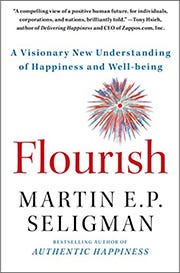
Flourish: A Visionary New Understanding of Happiness and Well-being
by Martin E.P. Seligman
Flourish builds on Seligman’s game-changing work on optimism, motivation, and character to show how to get the most out of life, unveiling an electrifying new theory of what makes a good life — for individuals, for communities, and for nations. In a fascinating evolution of thought and practice, Flourish refines what Positive Psychology is all about. With interactive exercises to help readers explore their own attitudes and aims, Flourish is a watershed in the understanding of happiness as well as a tool for getting the most out of life.
So, what’s on your summer reading list?
Tim Cynova is a leader, HR consultant, and educator dedicated to co-creating anti-racist and anti-oppressive workplaces through using human-centered organizational design. He is a certified Senior Professional in HR, trained mediator, principal at Work. Shouldn’t. Suck., on faculty at New York’s The New School and Canada’s Banff Centre for Arts and Creativity, and for the past twelve years served as COO and then Co-CEO of the largest association of artists, creatives, and makers in the U.S.
Opportunities to Live Our Anti-Racism, Anti-Oppression Values
By: Tim Cynova // Published: January 8, 2019
[This time of year brings a whole host of looking back, looking forward pieces. Instead of a round-up of the top books or movies, or predictions about what’s to come in 2019, I thought it might be a good time to check in on our anti-racism, anti-oppression journey at Fractured Atlas.]
A number of years ago when Fractured Atlas was beginning in earnest our journey towards becoming an anti-racist, anti-oppressive organization I asked someone working in the space if they could point me in the direction of case studies about other companies with similar complexities to ours who were doing the work well. (When embarking on something new, I often scan the space to see what kind of learning is available that I can leverage and then iterate on in our own work.) The person essentially said, nope, they couldn’t think of any, but that people were watching Fractured Atlas as we embarked on this journey and would be interested to see how we approached it. That was about four years ago.
Lauren, Lisa, and I at TCG’s CultureMakers gathering. (Photo: Ryan Bourque)
Increasingly in recent months, my Fractured Atlas colleagues Nicola Carpenter, Courtney Harge, Lauren Ruffin, Jillian Wright, our Board member Lisa Yancey, and I have had opportunities to chat with awesome people around the country about where we are in our organizational journey, and share ideas and experiences around the “how” of operationalizing commitments to creating anti-racist, anti-oppressive (ARAO) teams and organizations.
It’s not uncommon for us to meet with those in predominantly white organizations and find people wanting to do the work, but not sure exactly how to approach it. In the absence of a template, clear path forward, or “buy in” from their board of directors, they remain stuck. And in doing this work, it quickly becomes evident that we’re either moving forward, or we’re falling behind.
There is no neutral. Racism and oppression don’t take days off.
Specific Things We’ve Been Doing
We created the image below as a kind of snapshot of what’s happened over the past few years during our ARAO journey at Fractured Atlas. The graphic (and duplicate list below) includes things we’ve explored and implemented to support the creation of a more diverse, inclusive, and equitable workplace, and some significant milestones that have occurred along the way. The image is the result of a quick, almost stream-of-consciousness round up of the many things we’ve experienced at Fractured Atlas, with many happening in the past two years.
A snapshot of opportunities from the past few years that have allowed us to live our ARAO values at Fractured Atlas. (Not necessarily listed in chronological order.)
Committed to becoming an anti-racist, anti-oppressive (ARAO) organization
Created staff ARAO baseline & provide monthly race-based caucuses
Crafted ARAO Community Guidelines & created a staff review committee
Developed Negative Interactions Protocol to guide challenging interactions
Acquired & integrated our for-profit software development subsidiary
Developed four-person, shared, non-hierarchical leadership structure
Founder & CEO departed after 20 years
Launched an impact investment fund focused on the intersection of exponential creativity & technology
De-siloed our four core programs into one Programs team
Adopted Objectives & Key Results (OKR) framework for increased transparency, alignment & accountability
Launched all staff core curriculum training
Introduced unlimited vacation days
Focused on employer brand & unbiasing hiring process; training more staff to interview & hire
Published How We Work: A Guide to Working at Fractured Atlas
Created a humane, respectful, trusting, and flexible hourly-based staff tier
Cradle-to-grave family leave policy & structured support
Strict fixed-tier compensation structure
Renovated HQ with eye towards how physical space can best support people’s work
Global Board with members in 4 countries, 6 time zones, and 2 people joining from tomorrow
Transitioning to be fully virtual organization by January 2020
Oh, almost forgot! We launched a companion site for this work at Work. Shouldn’t. Suck.
The list is by no means exhaustive. It’s been an incredibly busy couple of years filled with exploration, change, and iteration on many fronts. (Here is a round up of changes we experienced in simply one year alone.) This list also largely omits numerous changes in our programs and services, as well as developments in our software and technology infrastructure — both of which have experienced an entire grid of activity in their own rights — in favor of focusing more on ones firmly intersecting our People Operations work.
What If? How Might We?
Each tile on the grid above reflects opportunities where we asked ourselves a series of questions that usually began with a “What if?” or “How might we?” How might we better live our anti-racism, anti-oppression principles to serve our amazing members? How might we craft an organization that is more diverse, more inclusive, and more equitable as we approach this new thing? How might we create a workplace where more of our coworkers can thrive and make their dents in the universe?
Then we got more granular: What if we approached designing an organizational leadership structure that was more reflective of our ARAO values rather than how conventional “wisdom” suggests organization to structure hierarchically? How might [insert item] be an opportunity for us to better reflect our ARAO commitment, support people, and move our organization forward? If we all don’t live and work in the same city, how might we build a unified organizational culture, rather than one that varies depending on where someone is located?
Each item in the grid could have its own blog post, if not a book, delving into the how, the why, the stumbling blocks, and the lessons learned. Fortunately, we *have* written about some of these efforts here, here, here, here, and here. (And have more pieces in development.) Other items we dive into more deeply during our Work. Shouldn’t. Suck. bootcamps, HR Hours, and brown bag lunch chats with various organizations.
Has It Made Any Difference?
Looking at staff composition is one way — but certainly not the *only* way — of seeing how this work, and our journey, has impacted Fractured Atlas. Given that when we began this work we were a white-led organization with only one or two people of color on staff; we primarily worked from one office in New York City; and, we only had white men on our software development team, personnel metrics became a helpful proxy. Below is a snapshot of how those demographics changed over a five-year period.
A few of the metrics we tracked to see how our staff composition changed over 5 years.
Moving Forward in Ambiguity
The journey certainly hasn’t been without challenges, as any foray involving change is certain to include. (I wrote an entire piece about the psychological impacts of change here, and we’ve ticked off numerous instances of each during this journey.) We have and continue to struggle in places, and encountered unexpected hiccups in others. We made the best decisions we could at the time and then, importantly, iterated when things didn’t work out as we had hoped. This process continues to this day because, once on this journey, the work never ends.
There’s still no reliable template that I’ve found to do the work of dismantling racism and oppression in the workplace, which often leads to expressions of disappointment when people ask. It all depends really. It depends on where you are as a team and organization. It depends on your available resources. It depends most of all on your joint commitment — staff and board — to do the work, especially when it seems hardest and like you’re not making any progress. We move forward in ambiguity, an old friend of mine used to say, and we keep moving.
Because this work, and world, are ever evolving, we at Fractured Atlas couldn’t even follow the path we took if we were to do it all over again. That’s a liberating thought, though. The work is bespoke. All of us can use our creativity — wherever we find ourselves in our organizations — to move it forward. Simply reflecting on this question can yield helpful ideas: How might the decisions I make right now about [this thing] move us towards a more diverse, inclusive, and/or equitable team and organization? We all have agency, even if it might not initially seem so.
Ideas to Explore
Creating a negative interactions protocol and starting monthly race-based caucusing are great ways to move the work forward. But, depending on where you and your organization are in the journey, there might be other things you want to explore first. Might I suggest a few items for your consideration?
Here are a few ideas:
Begin introducing yourself using your gender pronouns, and ask others theirs. List yours in your bio or email signature.
Start a staff book club to explore new ideas and skill development. Might I suggest something from the lists here, here, and here.
Bring more new ideas and perspectives to your work from outside of your sector through a regular Visiting Professionals Series. #ProTip: Ask your Board chair to be the inaugural guest. Or, ask someone from a group who’s doing diversity, inclusion, and/or equity work to come and share their journey.
Strengthen board/staff connections and understanding by having an annual board/staff reception before a board meeting. It doesn’t need to be fancy, the sheer act of getting people together will be appreciated by those in attendance.
Take a few minutes to complete the Core Values Exercise Patrick Lencioni details in The Advantage. Why?
Learn more about how to create high-performing teams and organizations by listening to Adam Grant’s Work/Life podcast.
Are you a White person? Listen to Scene on Radio’s Seeing White series and use the study guide resource to discuss it with other white people. Or explore similar resources.
Increase organizational transparency and understanding by circulating your board meeting packet — unredacted — to staff. Then, take questions about the contents during your staff meeting. #ProTip: Use Google Forms to create a way to anonymously accept questions. This is particularly useful for sensitive inquiries or for staff members who might otherwise feel uncomfortable standing up in front of the entire organization to ask a question.
Level up that transparency — share the agenda from your leadership team meetings with the entire staff.
Recognize that resilience and self-care are a crucial part of this work if we’re to be successful. Check out my suggestions on that work here.
Google’s re:Work site offers a wealth of free resources, including for Unbiasing & Strategic Hiring.
Speaking of strategic hiring, remove educational requirements from your job postings. Why?
Make space for the different ways people process information by introducing a 30-second “Introvert Pause” after asking a question in meetings.
Formalize the members of your People Operations team. #ProTip: Members don’t need to focus 100% of their day on People Ops. For instance, the three members of the Fractured Atlas People team — Jillian, Nicola, and I — split our time, in various proportions, over FinPOps (Finance, People, and Operations).
Questions? Want to explore this more? Let’s chat!
If you have questions about how we approached anything on the list above, or other work we’ve done in the area, please ping us for a free HR Hour chat, apply to attend our upcoming Work. Shouldn’t. Suck. bootcamp on February 23 (deadline to apply is January 15), let us know if chatting with your board would be useful, and we also love lunch and brown bag-style conversations with teams too.
Register to attend our upcoming Work. Shouldn’t. Suck. Bootcamp if you’re interested in exploring more about how these tools can be used to create high-performing teams and organizations.
Tim Cynova is a leader, HR consultant, and educator dedicated to co-creating anti-racist and anti-oppressive workplaces through using human-centered organizational design. He is a certified Senior Professional in HR, trained mediator, principal at Work. Shouldn’t. Suck., on faculty at New York’s The New School and Canada’s Banff Centre for Arts and Creativity, and for the past twelve years served as COO and then Co-CEO of the largest association of artists, creatives, and makers in the U.S.
4 Task and Time Tracking Approaches
By: Tim Cynova // Published: January 3, 2019
How many minutes each day do you spend drafting emails? How about attending meetings? Chatting on Slack? Water cooler conversing with coworkers? Do you measure it in any way? Or, when you think about it do you merely quantify the time simply as a “lot/little” or “more/less than I used to?”
So much of our day just rolls by in the blink of an eye. We arrive, we’re busy, we rarely get to — let alone finish — the things on our “Important List,” and then we log off for the day and go home. (A phenomena I’ve previously explored here with tips to address it here.) We seldom take time to measure the specific activities that fill our day, in what configuration they fill it, and how this is multiplied across our team and organization.
“Effective executives do not start with their tasks, they start with their time. They start by finding out where their time actually goes. Then they attempt to manage their time and to cut back unproductive demands on their time. Finally they consolidate their “discretionary” time into the largest possible continuing units.“ — Peter Drucker, The Effective Executive
Outta Sight, Outta Mind
It certainly *feels* like I’m spending all day composing and responding to emails, but am I? Is it because every five minutes I’m switching back and forth between different types of tasks in different domains? Running financial management reports; processing payroll; fixing the office WiFi that just crashed; writing a blog post; attending a team meeting. Maybe. Is it because I’m being interrupted every five minutes or so? [Ping. Slack alert!] Possibly.
For the record, I’m not assigning a good or bad, too little or too much to activities. It all depends on what you’re trying to accomplish, over what period of time, and with what resources. But, if we aren’t mindful of how these things show up in our day, it can easily slide towards the too much and negative side of the scale.
We often hear about working “smarter” not “harder.” For many of us, that prompt can evoke the response, “Well, I would try to find a way to do that if I wasn’t working so hard right now.” We find ourselves playing the Scarcity Paradox’s juggling game. And when that occurs, it often prevents us from accomplishing the things that positively impact our organizations and the world. And, *that’s* when we end up thinking if we only worked harder we could actually get it all done.
How to approach working smarter?
A time and task assessment might be a helpful way to get started and gather useful data for you and your team. Below are four approaches you can experiment with to lay the ground work for smarter working.
A pared down version of the one we used at Fractured Atlas
Approach # 1: Low Tech
Ingredients: Spreadsheet, piece of paper, and writing utensil
Several years ago, we had a system at Fractured Atlas where we’d take a week every six months or so to plot how each of us spent our time during the day. The system used a grid on a piece of paper and manual entry (and looked similar to the condensed version above).
Each person would jot the number of minutes they spent emailing members, each time they did it. Then the amount of time spent processing donation checks. Then how long it took them to review a grant proposal. Then how long they were on the phone with that foundation program officer. Imperfect yes, but it gave us a rough sense for the amount of time we were all spending on various activities throughout the day.
We could use this information to see roughly how much of our week was spent on email, phone, in meetings, etc. We could see the program areas and activities where staff spent the most time working. We could see if people bounced from activity to activity, or worked in long stretches on specific tasks. We could then use it as the basis for inquiry and self-reflection about what approaches might yield the most productive results, and areas where we could make wholesale adjustments to improve things across the organization (i.e., No Meetings Friday).
If you have a tool like Excel or Google Sheets, it’s a fairly simple template to create. You can even take our format above and tweak it to suit your domain areas and tasks. Then, use it for a week. The data won’t be exact, but if you’ve never done this before, you might end up with some interesting information.
One of those days when you’re between Thinking, Meeting, and HR.
Approach #2: High Tech
Ingredients: A Timeular; iOS or Android device, and/or Mac or PC
Those looking for a more accurate tool to slice and dice a time and task assessment might want to use a Timeular. It’s a physical device that syncs with an app on your phone or computer to provide you with fine-grain activity data.
The first step after pulling the Timeular out of the box is to assign each of its eight sides with a specific type of work to track (i.e.., Email, Phone, Slack, Writing, Meeting, Thinking, etc.). The idea is that these task types should be universal to your work and independent of the content (e.g., “Email” versus “Emailing About Accounting”). Timeular allows you to create tags in the app to further slice and dice activities to gain more insight into various projects (like the amount of time spent on all activities related to receiving that grant). Now, you’re ready to go.
Physically flip the Timeular so “Email” is facing up, and start reading the email from that program officer. Move it to “Meeting” when you head into the team’s daily stand-up to discuss the proposal. Then flip it to “Writing” when you start drafting that grant proposal. At the end of your day, you have a colorful depiction of how you spent your time, in the exact order, and on which projects. Then, you can dig into the flow.
Do you see large chunks of specific work in the morning and then bouncing back and forth in the afternoon? Do you tend to focus on grant proposals in the morning and accounting tasks in the afternoon? Why? Maybe you want to put a block on your schedule in the morning to protect your time for writing, and then slide that grab bag of quick, relatively mindless items to the afternoon.

Approach #3: Human-to-Human
Ingredients: Another human being, preferably someone who doesn’t know the exact contours of your work. An inquisitive mind seeking to understand. The questions below, and a bit of self-reflection.
I recently had a conversation with someone who was stressed about the lack of time to get their work completed during the workday. Sensing a disconnect with what *they* meant when they said “work” and what *I* assumed they meant, I asked them to specifically define it all for me.
We started with questions like: What kind of work do you do during your day? Do you do any “work” before arriving at the office? What does that look like? Walk me through your day from one thing to the next and how you approach it. When you arrive at the office, what’s the first (second, third, etc.) thing you do? Is that what you did last week? Last month? Do you ever feel like you’re in “flow,” when you effortlessly make progress and the time flies by? When do you feel that way? When do you feel like you get your best work done? First thing in the morning, late in the day, on the weekend? How do you define “best work?” When you say you’re “writing a proposal,” what specifically does that process look like?
After everything was on the table, we dove into the reasons, value, and approaches of doing each thing. Why do you do that? How do you approach writing emails? How do you prepare for meetings? Why do you do it that way? Habit? If you *couldn’t* do it that way, how might you approach achieving the intended impact? Do you rate [that activity] relatively more or less important than [the next activity on your list]? What would happen if you flipped that activity to the afternoon, or Tuesday, or once a month?

Approach #4: Mindful Process
Ingredients: Thought & intention
You don’t need to buy a fancy gadget to track your time, or stop and write the minutes on a piece of paper next to you. You can simply start by being more mindful of how you’re working. “I’m switching from Email to Slack.” “I’m stopping writing to go meet with someone about hiring a new staff member.”
I recently ran across this study in the Journal of the Association of Consumer Research that found “the mere presence of our phone — even if it’s powered off, and even if you’re actively and successfully ignoring it — reduces available cognitive capacity.” (The New York Times published an article about the specific phenomenon.) I’ve been trying to keep my phone hidden in my bag so at least there’s additional friction of me mindlessly reaching into my bag to check tracking on my delivery from Amazon, or Twitter, oh, Weather. Is it going to snow? The simple act of thinking about reaching over helps me cut down on that activity. “It’s sooooo far away, I don’t have the energy.”
In a similar way with my phone, the motion it takes to flip the Timeular, or to pick up the pen to write the minutes I just spent doing a task, serves as a similar reminder. Just thinking about reaching over to pick it up and hunt for the next activity, cuts down on quick switches and helps me stay focused on the task at hand. And when I do reach for it, I’m more mindful of what I’m switching to because I literally need to find the word “Email” on the Timeular before popping open Gmail and diving in.
You don’t need a tracker to use this approach, and you don’t need to wait until you’re in the office to try this. When you wake up each morning and reach for your phone to bounce through apps — Facebook, Instagram, Weather, Email, News — mindfully note which ones you click on, which you feel like you get the most value from checking, and approximately how long the entire process takes. Reflect on how that whole morning routine makes you feel? More stressed out about the coming day, or more centered about how you’ll approach your day and at ease?
Maybe try skipping the morning app routine for a week. Just roll out of bed and go. Or, start with a waking up meditation like this one by Alexis Santos before you pick up the phone.
Making Sense of It All
You probably only need a week or two of data to start seeing useful patterns. Once we start to mindfully observe the activities of our day, and unpack our approaches, light bulbs begin going off around “smarter”solutions. What kinds of work do I do that I should do at home before going into the office? What kinds of work can I only do when I’m *in* the office? Where and how can I slot my proactive work (writing grant proposals) in the day to separate it from the reactive work (donors needing me to answer their gala inquires) that always seems to encroach on it? Can I block off 8:00–10:00AM each morning to just write. Can we all agree to “No Meeting Friday?”
The beauty of doing this kind of assessment with your team is that you can all help and hold each other accountable for the solutions you pick. Ugh, I know if I get up and do that, Pallavi is going to call me out for not sticking with the thing I’m supposed to be doing. It’s a peer pressure form of accountability.
Give an activities assessment a try and please let me know how it goes for you.
Register to attend our upcoming Work. Shouldn’t. Suck. Bootcamp if you’re interested in exploring more about how these tools can be used to create high-performing teams and organizations.
Tim Cynova is a leader, HR consultant, and educator dedicated to co-creating anti-racist and anti-oppressive workplaces through using human-centered organizational design. He is a certified Senior Professional in HR, trained mediator, principal at Work. Shouldn’t. Suck., on faculty at New York’s The New School and Canada’s Banff Centre for Arts and Creativity, and for the past twelve years served as COO and then Co-CEO of the largest association of artists, creatives, and makers in the U.S.
A Journey in Cultivating Resilience
By: Tim Cynova // Published: December 13, 2018
Apps, articles, books, and courses to build a reflective & resilient self-care practice in your life & work
After months of seeing that documentary about tiny homes pop up repeatedly in my Netflix queue, I finally sat down and watched it. And that lead to watching this one about adopting a minimalist approach in life, and then books like Dan Harris’s 10% Happier and Jeffery Pfeffer’s Dying for a Paycheck, and a course on Mindfulness-based Stress Reduction. By that point, I had fallen firmly down a rabbit hole of research on resiliency and self-care.
Much of my day is focused on crafting high-performing teams and organizations that have commitments to anti-racism and anti-oppression. I’m increasingly focusing on how resilience and self-care can be core to these environments and what that looks like. As someone who often goes around thinking, “Oh, that’s interesting, I wonder if, what, and how [insert thing] can be applied to building great workplaces where people thrive,” this felt like I’d stumbled upon a treasure trove of terrific thought material.
When we say we don’t “have the time,” we’re saying we don’t have time to invest in our own happiness.
It’s often the hardest, when we need it the most, to tap into the antidotes that allow us to take care of ourselves and remain resilient. When we say we don’t have the time for this, we’re saying in fact that we don’t have time to invest in our own happiness, and a search to lead a fuller life, truly living and thriving. We’re actively deprioritizing ourselves, our own happiness, and our search to align our interests to live with meaning and purpose. And for what in exchange?
Don’t be a martyr for your work, and don’t ask it of others
Ever since I was handed a Tonette back in 4th grade, I was on a path to life in the cultural sector. While I often use that frame of reference when thinking about workplaces, there’s nothing unique from a human perspective about working in the private or public sectors. In the nonprofit sector, we like to tell ourselves that there is something special — often when someone is trying to justify unrelenting working conditions and low compensation levels — but for the most part we’re human beings, spending our time trying to accomplish something.
The twist here for those of us in the nonprofit sector — and the sad irony really — is that this sector exists to make the world a better, more beautiful, and understanding place. And it does this in large part by burning through its people. Rather than accept this as the way it is, or the way it has to be, let’s actively reject this notion in favor of finding ways to create better, more sustainable places for people to work, be resilient, and thrive.
If you thought the Atari 2600 was awesome, you *have* to try this new game called Stop.
The Hottest New Game for the Holidays
Here’s the cool, new game I’m playing when I catch myself feeling frenetic: it’s called, Stop. Nope, not some fancy acronym or new management framework popularized by Google. The word simply says it all. Stop pushing. Stop running from meeting to meeting. Stop hopping from email to email and call to call. Stop. Just for a moment, right where you are and what you’re doing.
Stop. Relax your shoulders that have found their way up to your ears. Part your teeth to relax your jaw and muscles in your face. And then take three, slow, deep breaths in and out. As you do, sweep your body to identify where you’re holding tension — shoulders, knees, toes, knees, toe (oops, wrong game) — and feel it melt away as you exhale. If you’re seated, feel yourself sink deeper into your chair each time you exhale. And that’s it, the 60-second Stop.
What?! I don’t have time for that, Tim. Well, here’s some quick math. There are 144,000 seconds in a 40-hour workweek. Now, trust me (and I’m looking at you, future Tim!), we all can afford a few 60-second stops throughout the day.
How do I use the resources below in my workplace?
The possibilities are endless! I encourage you to just take 4–5 minutes to think about what resilience and self-care looks like in your own organization. Ask yourself simply: Is my workplace safe? Safe for everyone who works here? Is it a healthy place for everyone who works here? Can people live and work with ease? With joy? Why or why not? Then dig into those answers and whether you can find ways to do more of the positive and address the negative.
I’ll wager if you and your coworkers start asking, “How might we make resilience and self-care a greater part of the way we work?” you all will come up with a whole host of terrific options that suit the way you want to work. You might simply start by asking other coworkers what they do for their own resilience and self-care. With that seemingly simple question it puts the topic on the table and no longer is out of sight, out of mind.
Then, work together. Create a book or podcast club. Share resources and articles on a Slack channel. Schedule meetings to be walking meetings, or simply just outside. Take assessments and discuss what you make of the results. Make time during your all staff meetings for people to share their self-care approaches. Start each meeting with two-minutes of guided breathing like the 60-second Stop game above. (It might be the only two minutes of someone’s day when they can just sit quietly and realize they’re breathing.)
OK, so I promised you a sampling of the apps, articles, books, and courses that I’ve explored since stumbling upon that tiny home documentary. In the spirit of putting your oxygen mask on first before helping others, I hope you find some value in them.
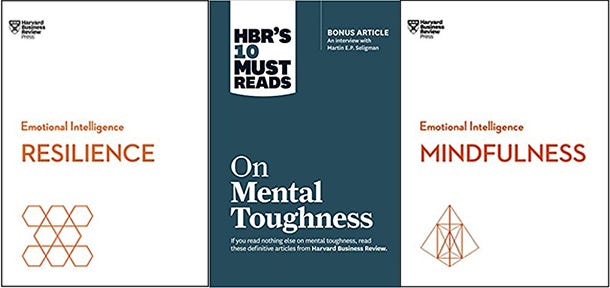
Want to know more about what I mean when I say “resilience”? Harvard Business Review offers plenty of articles on the various aspects of it in Resilience, Mental Toughness, and Mindfulness.
One of the tips I took from these readings is, when flying, don’t try to work. You might be like me and have a list of the work I plan to accomplish on the plane. Then, because the seats are too small, my neighbor’s eyes are reading along, and the GoGo wireless is frustratingly slow, I arrive on the other side exhausted and without feeling like I “got the jump” on things. Take the time on this last connectivity-free bastion to read for enjoyment, watch a few movies, meditate for hours. Arrive refreshed and less stressed. You probably wouldn’t have made as big of a dent in your work as you hoped.

Part of building resiliency is understanding and being able to articulate what we value, and what drives and motivates us. This becomes like a north star to direct our efforts or, in the words of a mentor of mine, “If you don’t know where you’re going, you’ll have a hard time knowing if and when you ever get there.”
Tasha Eurich’s book and accompanying workbook for Insight: The Surprising Truth About How Others See Us, How We See Ourselves, and Why the Answers Matter More Than We Think provides prompts to consider and assessments to take if you need a little push to get things rolling. The workbook helps readers articulate answers to questions like: What are your values? What are your passions? Your aspirations? Your ideal environment? And whether you have any unknown unknowns. Think what you’re doing in life might not be aligned with what you should be doing? Take a validated assessment like the free Holland Occupational Themes here, or the slightly more aesthetically pleasing version here.
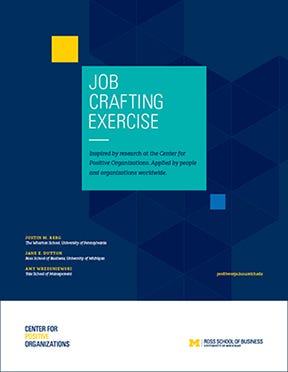
No mention of aligning interests and motivators in work and life would be complete without a shout out to the work of my friend and Yale professor Amy Wrzesniewski. If you haven’t watched her talk about creating meaning in your work, read about the impact of having multiple motivations, or worked through her Job Crafting workbook, take a moment today.
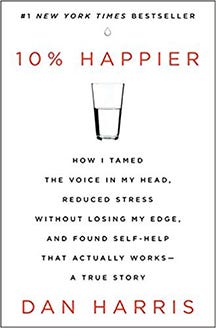
There are plenty of articles ranking the top meditation apps, so I won’t spend the ink here. I started using 1GiantMind and have found helpful meditations on Insight Timer. But, my go to meditation app right now is 10% Happier. In particular, I enjoy the courses by Joseph Goldstein and Sharon Salzberg (co-founders of the Insight Meditation Society in Barre, MA). Oren Jay Sofer’s courses on Communication dovetails nicely with my mediATION work, and Alexis Santos helps remind us that we can be present and mindful in real-time when we’re brushing our teeth, commuting, standing in line, or using our smartphone.

It’s only a matter of time when digging into resilience and self-care that you land on the topic of happiness. I’d encourage you to check out How to Be a Positive Leader: Small Actions, Big Impact. This collection of essays features some of the leading thinkers on the subject. Shawn Achor then dives into principle of positive psychology in his Happiness Advantage. And the video Flow, the Secret to Happiness is by noted Positive Psychologist Mihaly Csikszentmihalyi. (If you’ve heard or used the phrase, “being in flow,” you’ve referenced Csikszentmihalyi’s work on the psychology of optimal experience.)
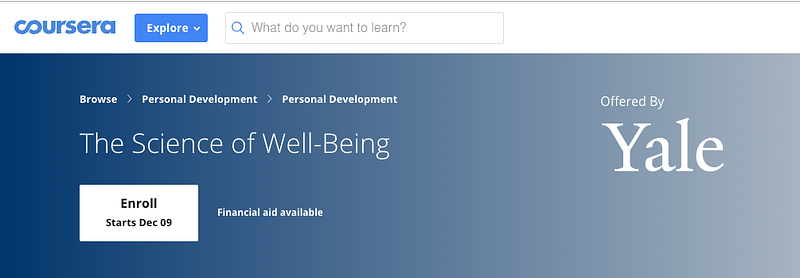
For those looking to dive deeper, The Science of Well-Being (a version of Yale’s most popular class ever) is free on Coursera. It’s a great exploration that includes a lot of the research behind why what you think will make you happy in life won’t make you happy, and then what to do about it.
I particularly enjoyed the resource section of this course as it linked to many of the studies I’ve read about over the years that keep showing up in the literature. Like the one by Kahneman and Deatman finding that once people earn around $75,000, each additional dollar contributes incrementally less to their happiness than the one before it. And also the study that found, on average, people feel like they need to earn to 40% more than they currently make to be happy. Meaning, the more we earn, the farther we move away from the absolute dollar amount that we think will *finally* make us happy.

And for those who *really* want to go deep into positive psychology without going back to school, the Foundations of Positive Psychology is a five-course specialization on Coursera by the team from UPenn (one of *the* places to study the topic). It’s relatively inexpensive, but not free.
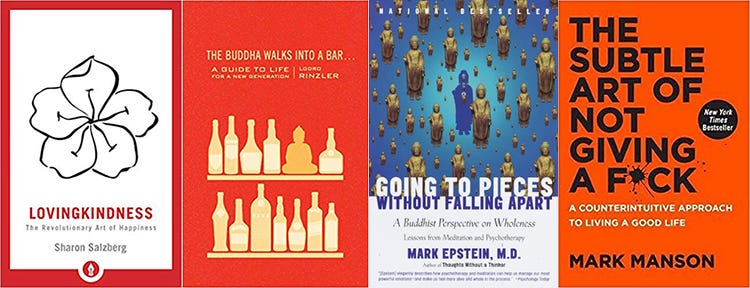
It was about this point that I read a bunch specifically on mindfulness and meditation, including: Mark Epstein’s Going to Pieces Without Falling Apart; Sharon Salzberg’s Lovingkindness: The Revolutionary Act of Happiness; Sam Harris’s Waking Up: A Guide to Spirituality Without Religion; Robert Wright’s Why Buddhism is True; Jack Kornfield’s The Wise Heart: A Guide to the Universal Teachings of Buddhist Psychology; and Lodro Rinzler’s The Buddha Walks Into a Bar. And the related but different: Mark Manson’s The Subtle Art of Not Giving a F*ck: A Counterintuitive Approach to Living a Good Life; and, Carol Dweck’s Mindset.

In addition to Erik Barker’s Barking Up The Wrong Tree: The Surprising Science Behind Why Everything You Know About Success Is (Mostly) Wrong, Barker compiles the latest research in a weekly book report of sorts to remind us that so much of what we think is true really isn’t. I particularly enjoyed his piece “How to Avoid Burnout: 3 Secrets From Research” recapping Maslach & Leiter’s The Truth About Burnout: How Organizations Cause Personal Stress & What to Do About It. Spoiler: One of the antidotes to stress and burnout is doubling down on our relationships.
Research highlighted in Pfeffer’s Dying for a Paycheck
In another read, Dying for a Paycheck, noted expert in organizational behavior Jeffrey Pfeffer highlights research that shows having friends protects our health as much as quitting smoking, and a great deal more than exercising. What?! Even though, sadly, survey evidence suggests that the number of Americans who say they have no close friends has roughly tripled in recent decades.
To bring us down even further, Pfeffer uses secondhand smoking exposure as a measure against which he ranks the dangerous impacts of work that we often let slide. (You can see just one of the rankings as it relates to mental health in the image above.) For those of us working in the “gig economy” — like many artists — these work-related uncertainties make people particularly prone to being negatively impacted in areas like Work-Family Conflict, Unemployment, Low Organizational Justice, and Job Insecurity.
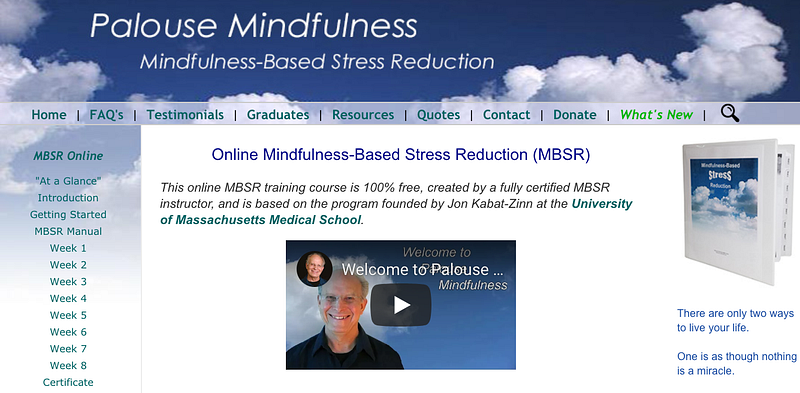
The Palouse Mindfulness-Based Stress Reduction is a terrific and free program I recently completed. It’s structured as an eight-week, roughly 50-hour course, and modeled on the MBSR framework started by Jon Kabat-Zinn at UMass Medical School. In-person MBSR courses can be found around the world, but Dave Potter graciously took his time to create this online version including videos, readings, meditations, and worksheets to track your progress. For those who complete his course, Dave even writes a personal email reflecting on your work. It’s an incredibly kind gesture.
I found MBSR to be a wonderful introduction into mindfulness, and various approaches to insight meditation, and it helped me figure out what works best when. (And reminded me that, yeah, I really don’t enjoy yoga.) Special thanks to my colleague Pallavi Sharma for tipping me off to this course. (On my list for 2019 is to check out Qi Gong as another tool for the toolbox. Pallavi recommends this video and this primer article to get started.)
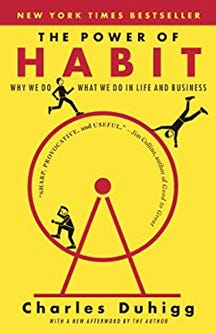
For many of us, we can’t simply change our decade’s old approach to life with the snap of our fingers. Charles Duhigg’s The Power of Habit: Why We Do What We Do in Life & Business not only includes some fascinating real-life anecdotes about changing behavior (like how to get more people to brush their teeth), but he also provides a framework for breaking or making new habits in your own life.
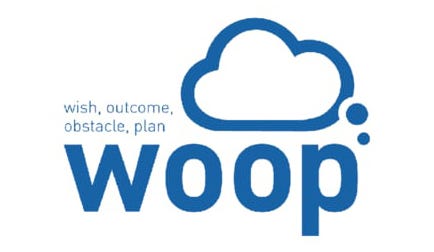
NYU psychology professor Gabrielle Oettingen (and author of Rethinking Positive Thinking: Inside the New Science of Motivation) offers yet another tool to accomplish goals. She called it mental contrasting, and used her research-backed approach to create WOOP (Wish. Outcome. Obstacle. Plan.) to help increase the chances of success. There’s even an app to “WOOP Your Life.”

Ever talk with people? Then you might want to check out Oren Jay Sofer’s new Say What You Mean: A Mindful Approach to Nonviolent Communication. One of the traits of high-performing teams is their ability to engage in healthy conflict. I’ll wager that for many, meetings feel like one painful conflict negotiation after the next. Oren’s guidance could mean the difference between carrying the negative impacts of conflict around with you, or mindfully examining them in a way to understand and let it go. If the conversation *is* the relationship, having better ones is key to being able to survive and thrive.
What do you find useful to build resiliency and self-care in your own life? Please drop me a note in the comments.
Interested in exploring more about how these tools can be used to create high-performing teams and organizations? Apply to attend our upcoming Strategic HR Bootcamp.
Tim Cynova is a leader, HR consultant, and educator dedicated to co-creating anti-racist and anti-oppressive workplaces through using human-centered organizational design. He is a certified Senior Professional in HR, trained mediator, principal at Work. Shouldn’t. Suck., on faculty at New York’s The New School and Canada’s Banff Centre for Arts and Creativity, and for the past twelve years served as COO and then Co-CEO of the largest association of artists, creatives, and makers in the U.S.
CEO Not (Necessarily) Required
By: Tim Cynova // Published: May 15, 2018
An Early Look Into Fractured Atlas’s Shared Leadership Model
Preamble
Those playing along at home will recall that Fractured Atlas recently embarked on a few new adventures. One of which is the creation of a four-person, non-hierarchical leadership team for the organization. (I recently shared a collection of research on the topic. If you can wait a bit longer, I’m publishing a subsequent post that distills the key findings from the hundreds of hours I spent reviewing material.)
At Fractured Atlas, we’re approaching our foray into shared leadership much like anything we attempt: as an iterative process that progresses through our R&D pipeline. This process began with deep conversations over several months between the senior leadership of our staff and board. These conversations allowed us space and time to question conventional and received wisdom, and explore questions like:
What is the role of an organization’s leader?
Why is an organization typically structured as a hierarchy with one person at the top?
What are the advantages and disadvantages of hierarchical structures?
Is there a way to use this CEO transition as an opportunity to experiment with a leadership structure that might be more in line with our anti-racism, anti-bias, and anti-oppression work?
Could we develop this while also experimenting with more organically self-forming teams? Perhaps an entirely geographically-disbursed organization?
Can this be accomplished without creating a “first among equals” on the team, or accidentally making the Board Chair the de facto CEO of the organization?
Can we be as innovative with our leadership and team structures as we aim to be when creating tools to help our amazing members?
Maybe.
The announcement that we were exploring a four-person, non-hierarchical leadership model at Fractured Atlas sparked quite a lot of interest. Some of that interest was admittedly accompanied by arched eyebrows and a skeptical “Oh, REEEEAALLLLY,” but almost universally people were curious to learn more about how the experience unfolded. What follows is a snapshot of where we are right now — an “interim report,” if you will — with an important caveat that where we are right now is constantly evolving.
How did we get here again?
On March 1, 2017, when Fractured Atlas founder and Chief Executive Officer Adam Huttler began his “non-battical,” the four senior leaders of Fractured Atlas began operating as a four-person leadership team. Over the subsequent year, until Adam’s departure from Fractured Atlas on December 31, 2017, this group coordinated strategy and tactics for the four “departments” of Fractured Atlas: Programs, Engineering, External Relations, and Finance/People/Operations (FinPOps).
At its October 2017 meeting, anticipating the departure of Adam Huttler as CEO of Fractured Atlas to become CEO of Exponential Creativity Ventures, the Board of Directors approved a one-year trial of a four-person, non-hierarchical leadership team to begin in January 2018. Titles for the four positions were equalized at the “C-level”, reinforcing the non-hierarchical nature of the team.
Why try this instead of launching a search for a new CEO?
Fractured Atlas is in the middle of a multi-year strategic initiative, shaped by the members of the Leadership Team and Adam Huttler. It would very likely slow the momentum of this plan to conduct a search and introduce a new, single leader into the organization at this time.
A non-hierarchical, shared leadership model helps advance the anti-racism and anti-oppression (ARAO) values Fractured Atlas is committed to. Hierarchical models imply that one person heads the organization and makes the ultimate decisions. A shared leadership model demonstrates a different, inclusive approach that is more in line with our stated ARAO values and fosters a diversity of voices, perspectives, and skills necessary for the organization to be healthy, well-informed, and successful.
Using a shared leadership team model lessens the organization’s dependence on any one person, and strengthens strategic thinking and decision-making capacity across a broader range of staff members.
Shared leadership models are nothing new and are commonplace in many arts organizations that have both an artistic and executive leader. There are examples of successful shared leadership models — as well as failed attempts — dating back thousands of years. The Leadership Team is studying a range of examples and is working to leverage learnings from those examples to construct the model that fits Fractured Atlas. I’ve been designated as the team’s point person on gathering and sharing relevant research and case studies (and recently spent my annual Think Week with a treasure trove of material on shared leadership, the role of the CEO, and global virtual teams). This is an ongoing conversation in the Leadership Team meetings.
Experimenting with a shared leadership model demonstrates Fractured Atlas’s willingness to question conventional wisdom and embrace challenge when we think it will offer leadership to the sector and produce better results for those we serve. Through sharing about our experiment with a four-person leadership team, we expect to be able to help a host of teams and organizations operate more effectively and efficiently in service to their missions and the field.
What exactly is being shared?
Four people collaborate to fulfill what is commonly considered the CEO function of the organization, which includes overall strategic planning, fundraising, program development, and technical and organizational management.
Fractured Atlas Leadership Team 2018: Lauren Ruffin (top left), Tim Cynova (top right), Shawn Anderson (bottom left), Pallavi Sharma (bottom right)
How is the Leadership Team structured?
The shared leadership team includes Shawn Anderson (Chief Technology Officer) who oversees Software Engineering, Tim Cynova (Chief Operating Officer) who oversees Finance, People, and Operations (FinPOps); Lauren Ruffin (Chief External Relations Officer) who oversees Development, Marketing, and Outreach; and Pallavi Sharma (Chief Program Officer) who oversees the largest team delivering our core Programs and Services.
How often does the group meet and communicate?
Important Note: Fractured Atlas’s four-person leadership team is entirely geographically disbursed. All four members live and work in different states: Lauren (New Mexico), Pallavi (New Jersey), Shawn (Colorado), and Tim (New York). This means they only see each other in 3D a handful of times each year. It requires them to be mindful of how they communicate and create alignment within the leadership team and the organization since they aren’t all sitting near each other in HQ on a daily basis.
In the year of Adam’s non-battical, the Leadership Team refined their decision-making processes, which now include: Weekly “tactical” sessions where the group reviews weekly activities and metrics, and resolves tactical obstacles and issues; Monthly strategy meetings where critical issues affecting long-term success are discussed, analyzed, brainstormed and/or decided; Quarterly two-day offsites to review strategy, competitive landscape, industry trends, and team and organizational development; Ongoing Flowdock exchanges, Zoom calls, and emails; a monthlymeeting with the Finance team to review budget and financial management reports; and other team meetings where Leadership Team members attend as appropriate (e.g., product development meetings between Engineering and Programs will include Shawn and Pallavi but not Lauren and Tim).
In addition, the Leadership Team spends an entire week in March, during the annual All Hands staff retreat, working in person with each other and the various organizational teams.
The Leadership Team meets by video with the Board’s Executive Committee on a monthly basis and on a quarterly basis with the full Board of Directors (January, April, July, and October).
How does the Leadership Team set strategy and create plans?
The Leadership Team sets overarching strategy and creates plans to execute that strategy through their monthly Strategy meetings and the annual budget process.
The overarching strategy is then made more concrete and practical through the development of quarterly, organization-wide Objectives & Key Results (OKRs) creating transparency and alignment with every team and individual staff member.
The OKRs are monitored closely on a monthly basis. As external conditions shift or barriers to implementing the OKRs emerge, the Leadership Team discusses these developments in their Strategy and tactical meetings and determines necessary adjustments.
What if the Leadership Team deadlocks on a decision?
A shared leadership team doesn’t mean that the group votes on every decision, or requires consensus on every matter. Each member functions as the CEO of their department, possesses a deep domain expertise over the related content, and is responsible for seeing that their operations support the agreed upon vision and strategy of Fractured Atlas. Where functions overlap, or where group agreement is necessary for success, more discussion is necessary and joint agreement is desired.
The Leadership Team operates to take everyone’s concerns into account, and ensure that all team members feel heard and understood. However, one of the hallmarks of high performing teams is an ability to engage in healthy conflict and resolve differences productively.
When managing conflict, the Leadership Team distinguishes between decisions of significance that impact the entire organization and ones that are more tactical. The Leadership Team practices “Disagree & Commit” for both varieties of decisions, but allows different amounts of time and weighting of votes depending on the decision’s nature. If, after healthy discussion and an appropriate time period for reflection, there are still differences of opinion about a matter, the “Disagree & Commit” principle is invoked.
In the event that the group can’t reach agreement on a decision of significance that impacts the entire organization, the team will present this matter to the Chair, who will decide with the Leadership Team if this is an issue to discuss with the Board’s Executive Committee.
How is the Leadership Team evaluated?
The annual self-assessment process for all staff at Fractured Atlas takes place during July and August. In the past, the Fractured Atlas CEO completed his self-assessment relative to explicit OKR goals and organizational strategy, the Chair of the Board canvassed Board members for input, and the Chair and the CEO discussed performance and future goals.
Informed by our ongoing research on shared leadership models, the Leadership Team is discussing the best approach to assessment in the shared model. Questions being considered include: How to best assess individual members relative to their own goals — is this limited to each person assessing themselves, or are the other members of the Leadership Team offering input? How should we assess Leadership Team members’ contributions to the Leadership Team? Are non-Leadership Team members of the Fractured Atlas staff involved in assessing the Leadership Team through a 360-degree review process? How should the Board participate in the assessment process?
What if a member of the Leadership Team needs to be reprimanded or terminated?
One of the key traits of high-performing, non-hierarchical teams is the ability for team members, and their coworkers across the organization, to hold each other accountable for their responsibilities and commitments. At Fractured Atlas, the transparent OKR process means that everyone in the organization knows every other staff member’s quarterly priorities, and how well each is doing in achieving those goals.
Holding each other accountable starts first with the members of the Leadership Team working to surface and address any concerns among themselves. If concerns can’t be resolved, then it will be brought to the attention of the Chair and, if necessary, to the Board’s Executive Committee to determine an appropriate action.
What happens when someone inevitably leaves the Leadership Team?
When a member of the Leadership Team leaves the organization, the remaining members of the Leadership Team will assess the role, determine if anything in the job description needs to be adjusted before launching a search, seek input from the Executive Committee, set out a plan and process, and then search for a replacement.
Given the importance of the members of the Leadership Team, and that the Board of Directors officially hires and fires members of the Leadership Team, it is likely that one or more Board members will be involved in interviewing and making final recommendations about the replacement.
Once the person is hired, the hard work of rebuilding the team with the new configuration begins. (More on this when further research is distilled.)
Who do Board members contact for questions, concerns, and to share their thoughts?
For matters specific to Programs, Engineering, External Relations, or People/Operations/Finance (FinPOps), Board members email the respective lead.
For matters relevant to the entire leadership team, or if it’s unclear who is best to field the inquiry, Board members email the leadership team’s group email. All four members of the leadership team receive emails to that address, and the appropriate member responds.
For meta-level or highly sensitive issues, Board members contact the Board Chair who can discuss it individually with a specific team member or as a group by adding a discussion item to the Executive Committee’s monthly meeting agenda.
This article isn’t meant to make you think that we have it all figured out — far from it — or that we didn’t approach this with concerns. We have our concerns, and discussed many in great detail, but think they are worth the risk. Healthy concerns are a part of innovation but they shouldn’t stifle innovation. If we waited on the sidelines until all of the concerns were resolved, we’d never risk and learn.
Risk aversion is a regret premium. A fee paid to avoid regret.
Tim Cynova is a leader, HR consultant, and educator dedicated to co-creating anti-racist and anti-oppressive workplaces through using human-centered organizational design. He is a certified Senior Professional in HR, trained mediator, principal at Work. Shouldn’t. Suck., on faculty at New York’s The New School and Canada’s Banff Centre for Arts and Creativity, and for the past twelve years served as COO and then Co-CEO of the largest association of artists, creatives, and makers in the U.S.
Think Week ’18: Shared Leadership Models
Photo by Oliver Fluck. (Image unfortunately does not represent the setting of my actual think week, which is more along the lines of small apartment in New York City.)
By: Tim Cynova // Published: March 30, 2018
I’m going off-the-grid for a sorta annual Think Week. On the docket for this year: process and distill learning from material related to non-hierarchical, shared leadership teams, the role of the CEO, and — if I have time (fingers crossed) — global virtual teams.
Many years ago, I became fascinated with the Think Week concept after hearing about how Bill Gates went into the woods for a week each year with a giant stack of reading material. I’ve been fortunate during my nine years at Fractured Atlas to be at a place — with stellar and encouraging coworkers — that supports similar kinds of exploration and knowledge acquisition adventures.
I’m in the process of writing a piece about Fractured Atlas’s journey with non-hierarchical, shared leadership models that we originally announced in this post. Meanwhile, I thought that I would share some of the content on the docket for next week. Stay tuned and see you on the other side.
The Secret Life of C.E.O.s [podcast]
Self-Managing Organizations: Exploring the Limits of Less-Hierarchical Organizing
Nobody’s Looking at You: Eileen Fisher and the art of understatement
The shadow of history: Situated dynamics of trust in dual executive leadership
Impact of dual executive leadership dynamics in creative organizations
Shared Leadership in Teams: An Investigation of Antecedent Conditions and Performance
The shared leadership of teams: A meta-analysis of proximal, distal, and moderating relationships
Reinventing Organizations [book]
Changing on the Job: Developing Leaders for a Complex World [book]
The Starfish and the Spider: The Unstoppable Power of Leaderless Organizations [book]
WorkLife with Adam Grant [podcast]
The virtues of hierarchy, structure and temporary teams [podcast]
Hierarchy is Good. Hierarchy is Essential. And Less Isn’t Always Better.
The dynamics of shared leadership: building trust and enhancing performance
A Meta-Analysis of Different Forms of Shared Leadership–Team Performance Relations
The shared leadership of teams: A meta-analysis of proximal, distal, and moderating relationships
Out of Sight, Out of Sync : Understanding Conflict in Distributed Teams
How Task and Person Conflict Shape the Role of Positive Interdependence in Management Teams
Shared Leadership: Reframing the Hows and Whys of Leadership [book]
Share, Don’t Take the Lead [book]
Alternative Approaches for Studying Shared and Distributed Leadership
What other content on these topics should I be exploring?
Tim Cynova is a leader, HR consultant, and educator dedicated to co-creating anti-racist and anti-oppressive workplaces through using human-centered organizational design. He is a certified Senior Professional in HR, trained mediator, principal at Work. Shouldn’t. Suck., on faculty at New York’s The New School and Canada’s Banff Centre for Arts and Creativity, and for the past twelve years served as COO and then Co-CEO of the largest association of artists, creatives, and makers in the U.S.
Scarcity and the Non-Profit People Paradox
By: Tim Cynova // Published: December 21, 2017
Resource scarcity leads us to borrow, and that pushes us deeper into scarcity. Why? Because when we have scarce resources we tunnel (i.e., we focus on the here and now, the fires, what needs to get done right now). Tunneling leads us to neglect. Tunneling today creates more tunneling tomorrow, and leads us to borrow — in a borrowing from Petra to pay Paula and eventually needing to pay back Petra with significant interest scenario — so that we’re using the same physical resources less effectively, placing us one step behind.
Then, we find ourselves needing to juggle. This creates a patchwork of delayed commitments and short-term solutions that need to be constantly revisited and revised. We don’t have bandwidth to plan a way out of the trap and, when we make a plan, we don’t have the bandwidth needed to resist temptations and persist. The lack of slack and capacity reduces our ability to absorb and weather shocks, and when we do have slack we use it to catch our breath rather than use those moments of abundance to create buffers against future scarcity.
Sound familiar? That’s the scarcity trap as paraphrased from the thought-provoking book Scarcity: Why Having Too Little Means So Much by Sendhil Mullainathan and Eldar Shafir.
How Does The Scarcity Trap Relate to Prioritizing People Ops?
When we tunnel on the urgent — things like making payroll, or getting people to purchase tickets to our events, or reaching our crowdfunding campaign goal, or producing the annual gala to raise funds… to make payroll and present our events — we often do so at the expense of the important, bigger picture, and without regard to the impact on our people and the opportunity costs such focus exacts on our organizations.
Instead, when we focus on prioritizing people, and their capacity relative to our other institutional concerns, we unlock a powerful force and leverage our competitive advantage. So, how much time, money, and slack would you need before you pushed People Ops to the number one thing on your list? And when contemplating that answer, take a moment to consider that our people *are* our organizations.
Prioritizing people — and an organizational culture that allows them to succeed and thrive — creates your competitive advantage.
In not prioritizing People Ops — effectively punting it for another day — you’re borrowing against them and won’t develop the systems to weather scarcity. If we only prioritize people when needing to hire them, we won’t attract and retain the level of talent needed for our organizations to build necessary slack, innovate, and change the world. We’re never going to have the resources to save ourselves. Why?
Most of us believe we’re working smarter not harder. The fact is though, we’re caught in scarcity’s flywheel and it’s cascading a fire fighting, scarcity mindset throughout our organizations, magnifying the problem as things become worse for everyone. We’ll never “catch up.” Worst of all, we’re often oblivious to what will help us out of the bind as we focus on the fires, or assume if we just score that big grant — come onnnnn, lucky major foundation grant! — or sell out our season, we’ll finally be able to get ahead.
Studies show that when our resources are scarce, we’re preoccupied by that scarcity. That preoccupation negatively impacts our intelligence. In side-by-side tests, when we’re distracted by our scarce resources, we perform worse on tests than when answering the same questions when not under resource pressures. (The difference is upwards of a 13-point dip in our IQ!)
Tunneling Tax
Our sector’s common refrain — or badge of honor, depending on how one views it — is that since we’ve been operating with scarce resources for years, we’re skilled at operating under these pressures. Well, maybe. Here’s another research finding: Experience in scarcity makes people better at operating with scarce resources, *but* it also creates tunneling and the related negative consequences. Tunneling responses — increasing work hours, working harder, foregoing vacations — ignore the long-term consequences of these actions.
We introduce quick fixes and patches that come back to haunt us. It’s like purchasing a cheaper washing machine that breaks down more frequently. Putting off a more important task for an urgent one — because we’re tunneling — is like borrowing at high interest. It might address an immediate need but, like that cheaper washing machine, it’s going to come back to haunt us, and require more of us, before we know it.
To deal with the future, we need bandwidth, but scarcity’s bandwidth tax means we can only focus on the here and now. And even when we’re lucky enough to have bandwidth, it can have surprising effects.
And when we get back to the start, we have fewer resources and are farther behind.
When Building Slack Feels Counterintuitive
When you’re already busy, and trying to cram even more stuff into your schedule, the tools to build slack feels counterintuitive. Rather than trying to cram everything into a packed schedule — I just need more time! — building in slack increases our ability to get things done. (Don’t believe me? Read the illuminating Example 2 below.)
What does this mean for us in the cultural sector? Sometimes there’s a way to solve a perennial challenge that runs counter to conventional wisdom. Sometimes it’s not about needing more money or more people.
Thought experiment: At a recent conference, I heard a speaker say, “In our overworked, under-resourced organizations, how are we supposed to make progress?” Well, what would it look like if our “overworked” and “under-resourced” organizations had exactly the same resources but weren’t overworked, delivered on their missions, and changed the world?
What would it look like if your Development Associate wasn’t slammed wall-to-wall with more work than could be accomplished during an eight-hour day. What if they had flexibility in their schedule? How could that slack help your Director of Development and development department be better able to execute their work (and when I say “work,” I’m also including time to think, dream, and experiment).
When you manage bandwidth and not hours, you start to see other benefits. Henry Ford is credited with popularizing the standard five-day, 40-hour work week. It wasn’t that he was benevolent. It was that he recognized it made workers more productive during their “on” hours because they were healthier, more focused, and made fewer mistakes.
What Can I Do About This?
First, focus on your people: what you are asking of them, the environment in which you’re asking them to do it, and the type of support and feedback they receive. Focus on building diverse teams that level up and break through in ways that homogeneous teams can’t. If everyone has the same relative background and experience, even if you have a moment to consider how to deploy resources if you didn’t do an annual gala, you’re less likely to end up with innovative alternatives.
Second, you can’t do everything and need to make tough choices about what can be accomplished. Again, what would it look like if overworked and under-resourced organizations had exactly the same resources but weren’t overworked and didn’t feel under-resourced? It likely would mean they’d have to make tough, probably painful, choices to consciously *not* do things they love. It’s like pruning your prized plant so it can grow and be healthier.
If you say, “We don’t have the resources to accomplish everything we need to do,” than you’re trying to do too much. You might reeeeaaaaaally love that thing, but if it’s undermining your ability to deliver on your mission without burning the place to the ground, you need to take it off the list. You need to stop doing it. Quality over quantity here. (See also: Don’t let the perfect be the enemy of the good.)
Lastly, once you’ve pruned and protected, get ready to lean in when you have periods of slack and abundance. It’s counterintuitive, I know. “I just need a break and a breather” is often the natural inclination. Kicking yourself into a higher gear when you have periods of abundance — and determining ways to smooth out the ebbs and flows — will enable you to bank slack for the future.
Can You Help Me Out Here?
Want to level up your People Ops to create more periods of slack and resilience? Here’s an extensive list of People Ops resources covering a whole host of topics. Want to chat about this or another People Ops challenge that’s on your mind? Connect for free HR assistance and ping me at hrhour@fracturedatlas.org.
Special thanks to my coworker Lauren Ruffin who introduced me to the resource scarcity research through this article that set me on this path of discovery, a journey that further solidifies my resolve that strategic People Ops are key to helping us address the challenges we face in the cultural sector.
Extra Credit: Illuminating Real Life Examples
Example 1: Chennai, India
One research study cited in Scarcity followed street vendors in Chennai, India. These vendors earn $1/day and take loans to buy their goods that charge interest rates of 5% daily.
The study divided people into two groups. The first group operated as usual: in debt, earning $1/day, and borrowing money at 5% daily interest to pay for their goods to sell. The second group was given a one-time infusion of cash to pay off their debts and break free from the trap. The researchers then tracked the two groups for a year. What happened?
Within a year, all the vendors were back in the same place, in debt, living on $1/day, and needing to take loans with 5% daily interest. Why? While they momentarily had bandwidth and slack, they didn’t have enough slack to weather the hits that would come along the way: buying school clothes and supplies for their children; unexpected medical bills for themselves and their family; and so on.
The Indian street merchant study offers a powerful, and sobering, example to those of us in organizations who “just need that one grant to finally have room to breathe.” “If we can just secure the $100,000 grant, we’ll be able to get ahead of the curve.” Even if we get it, we’ll likely find ourselves right back where we started.
Example 2: St. John’s Regional Health Center
When we’re tightly packed, we reduce slack. St. John’s Regional Health Center performed upwards of 30,000 surgical procedures a year in 32 operating rooms that were always fully booked. Staff were performing surgeries at 2AM, waiting hours for an open room, working unplanned overtime. “The hospital was like the over-committed person who finds that tasks take too long, in part because the person is over-committed and can’t imagine taking on the additional — and time-consuming — task of stepping back and reorganizing.”
The hospital would start the week with its operating room schedule. Before they could even get going, emergency surgeries would crop up that would bump elective surgeries, and then those elective surgeries would bump other elective surgeries later into the week until more emergency surgeries bumped those, and pretty soon people were operating late into the night and on the weekends. Knowing surgeries would likely be bumped, surgical teams would schedule all of the elective surgeries early in the week, which caused further bumping when the surgeries actually were bumped… which caused more bumping. This led to the teams being more exhausted, unhappy, and a general feeling that, “if we only had more operating rooms we could get this back on schedule.” (Sound familiar to resource constraints in your organization? If we only had x, y, z.) So, what did the hospital end up trying?
They realized that while a percentage of the surgeries were emergencies and were unplanned, they weren’t *unexpected.* The same thing happened every week. Here’s where a bold, counterintuitive approach came into play. The hospital took one of its operating rooms offline and allowed it to be used *only* for those unplanned, but not unexpected, surgeries. Everything else needed to be scheduled in the other operating rooms. As you can imagine, this move went over splendidly. Well no, people were furious, “How could you take away an already precious resource!?!?! We don’t need fewer rooms, we need more!!”
What they found was that with one operating room set aside for unplanned surgeries, the other surgeries weren’t being bumped as frequently. This in turn allowed teams to more confidently schedule elective surgeries for later in the week without fear that they’d roll into the late night or weekend. This evened out the schedule, reduced the long work hours and weekend surgeries, resulting in more focused teams that made fewer mistakes, and people feeling less stressed and unhappy. Voilà!
Example 3: New Jersey Transit
Those who ride the rails on a regular basis are well aware of this classic example. If there’s little to no slack in a system, then any train delay forces all the trains behind that one to be late as well. It’s impossible to “catch up” by leaving the station early. You can lose time, but never gain it back. Minor delays therefore pile up and quickly turn into major delays on a regular basis. (Example provided by my friend whose commute on NJ Transit provides him with daily reminders of why slack in systems is so important.)
Example 4: Slack vs. Fat
Corporate cost-cutting in the latter part of the 20th century famously resulted in “right sizing” and cutting “fat” out of companies. “Oh, you have an assistant who has work to fill about a third of the day? Well, now you share that assistant with two other people.” On the face this appears to make sense. Counterintuitively though, this created unintended cascading scarcity trap issues. Now the assistant had a full day’s worth of work but lacked bandwidth to help when something urgent arose. This meant that the urgent bumped the important with cascading effects to the three people they worked with and beyond.
Congratulations! You’ve completed the extra credit portion of this piece.
Tim Cynova is a leader, HR consultant, and educator dedicated to co-creating anti-racist and anti-oppressive workplaces through using human-centered organizational design. He is a certified Senior Professional in HR, trained mediator, principal at Work. Shouldn’t. Suck., on faculty at New York’s The New School and Canada’s Banff Centre for Arts and Creativity, and for the past twelve years served as COO and then Co-CEO of the largest association of artists, creatives, and makers in the U.S.
Work. Shouldn’t. Suck.: Why People Ops Can’t Wait Until Tomorrow
By: Tim Cynova // Published: November 22, 2017
This piece details a core belief of mine, and why, especially if you’re a leader in the cultural sector, I believe you should share it too.
Strategic HR — or People Operations — is a senior-level management competency that needs to be embedded in every decision we make in our organizations.
Why do we need to think strategically about our People Operations and embed it in everything? Why can’t we just give it to the “HR person”? Well, because this, for one reason:
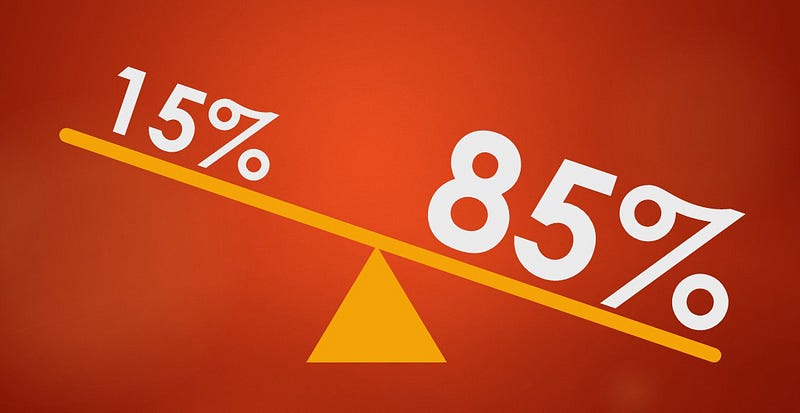
Gallup’s Worker Engagement Index found that, globally, only 15% of employees are engaged. Engaged employees are those with passion and who feel a profound connection to their company. They drive innovation and move the organization forward.
15% Engaged - 60% Disengaged - 25% Actively Disengaged = Not Great News
That leaves a whopping 85% of employees who are not engaged. Sixty percent of total employees are disengaged and essentially checked out. They’re sleepwalking through their workday putting time — but not energy or passion — into their work. And then there’s… wait for it… 25% of total employees who are *actively* disengaged — WOWZA!! That’s a quarter of employees who aren’t just unhappy at work, they’re busy acting out their unhappiness. Every day, these employees undermine what the 15% of engaged coworkers are trying to accomplish.
We have almost *double* the number of people actively working against us as working *for* us — inside our own organizations!
(I’m just going to pause to let that fun fact sink in.)
In letting this happen, we’re effectively setting a whole host of organizational resources on fire. All of those hard-fought resources you’ve been struggling to obtain and maintain? Poof, up in smoke. If you like money, think of it this way: Congratulations on receiving that $100,000 grant… minus the 85% disengagement tax… that leaves $15,000. Hope it was worth all the hard work.
Maybe those percentages are bearable if your organization has 50, or 100, employees — inertia in large organizations is a powerful force allowing some to operate incompetently for too long — but this is *catastrophic* when we consider that the vast majority of our cultural sector organizations are operating with fewer than 10 staff members. You, leader who is reading this, might be the only employee in your organization who is engaged, which means you have even more of a responsibility to do something about it.
Another gut punch
Before we explore how to use this information, here’s another fun fact: 51% of our employees are looking for another job. If by now you’re standing in a puddle of tears, I don’t mean for this news to break us down. There’s actionable intelligence we can glean from this group that can help us as we begin to approach our People Ops work more strategically. It might be painful intelligence for us to receive, but it’s necessary to move forward strategically.
Overall, the news from Gallup’s Engagement Index is slightly better for those of us working in the U.S. and Canada. Only 7 of our 10 employees are disengaged instead of 9 of the 10 globally. Even this relatively positive news though results in a kind of stalemate tug-o-war where engaged employees versus the actively disengaged employees tire each other out as they remain locked in place. In this scenario, we’re essentially betting our organizational success on our disengaged staff. (My heart goes out to cultural sector colleagues working in Britain who have 8% engagement, and Japan who have 6% engagement.)
Work shouldn’t suck.
As leaders, we are shirking a core responsibility if we allow this to happen without continually trying to do something about it. And, if after reading the statistics above, you get mad like me and say, “Damn right, work shouldn’t suck for me or anyone else,” then demand that more of our cultural organizations — organizations dedicated to making the world a better, more beautiful place — don’t do it by burning through staff.
Our organizations are chocked full of creativity, let’s harness it to create innovative workplaces — with a sense of shared purpose — where people can do their best work and thrive. That’s the *least* we can do, because doing that affords us the ability to actually change the world while treating employees with respect and humanity.
This creativity can start simply by questioning conventional wisdom and how we’ve always done things. Why do we include that educational requirement line in our job postings? Why are most of our offices essentially replicas of the ones our grandparents worked in 50 years ago? How could we work in ways that better reflect the way people live and work today? How can we demonstrate anti-racist and anti-oppression values in our workplace? When technology gives us access to billions of talented people around the world, why do we still centralize organizations? What’s the purpose of our staff meeting? Is it an effective use of the most expensive meeting our organization regularly holds? Why do we do that thing on an old computer that repeatedly transforms a 60-second process into a 20-minute struggle thereby eating up hours of staff time a week?
If, even after the above, you’re still skeptical that strategic People Ops is worth it, I’ll give you one last data point: research shows people who work in alignment with their motivators — who feel engaged in the work they’re doing — produce higher-quality work, have greater output, earn higher incomes, and are 150% more likely to live a happier life.
Not just for Executives
While my argument is mainly aimed at senior leadership and organizational decision makers, the responsibility doesn’t rest solely on their shoulders alone. People Ops, and great company culture that permeates the entire organization, isn’t possible if it’s just the Executive Director. You can lead from wherever you currently find yourself in an organization. Leaders can be separate from from managers, supervisors and executives. Some of the people in those positions aren’t leaders. And vice versa, a person on the bottom rung of a hierarchical org chart can be a culture carrier and leader within their organization and influence its trajectory more than formal leaders. With this in mind, what can we all do about the disheartening figures above that impact us all?
Start Somewhere, Anywhere
Don’t know where to start? Start by imaging a place where your most idealistic self would love to work and where you could thrive. Don’t let years of scarcity mentality and “this is how it’s done in non-profit” compromises anchor you to an environment that you merely put up with it. Even if you love your job, there are bound to be things you’d like to change that would make you more engaged. For instance, I love what we’ve built, and are building, at Fractured Atlas, but I’d still love if it was a little more Big Island of Hawai’i adjacent and/or had vistas where I could just stare across them and imagine how we can implement things to be even better.
Again, this doesn’t just need to be all on the shoulders of the organization’s leader. Making People Ops more central to an organization’s strategy and tactics involves everyone in the organization as you explore and identify things large and small. It also doesn’t have to be on level with a total office redesign. Early in my Fractured Atlas tenure, we just wanted a place to wash our lunch dishes that wasn’t the tiny sink in the tiny restroom. Small wins can sometimes make a huge impact in our level of engagement.
If you’re someone who finds yourself in the 85% of disengaged workers, might I suggest looking at Amy Wrzesniewski’s work. Amy’s research focuses on finding meaning in one’s work, and includes a job crafting toolkit to help you create the job you want from the job you have. Or, take a look at Chester Elton and Adrian Gostick’s What Motivates Me assessment. While leaders have a responsibility to help create the environment where great things can occur, we all have a responsibility to own our part of the work.
No one will care more about you and your career than you. You’re the CEO of You Inc.
If you’re stuck and feeling helpless, ask yourself, “What can I do right now to move towards what I really want?” (You have more options than you think.)
Leaders don’t set out to make work suck
Most leaders don’t set out to create and run organizations where work sucks. They, like the regular human beings they are (even if some seem larger than life), are trying to do the best with the hand that’s been dealt. Sometimes we don’t know what we don’t know and that leads us to make wrong decisions, or ones that unintentionally devalue something that has a significant impact on our organization’s ability to deliver on its mission. This isn’t surprising given the Scarcity Trap that snares many non-profit executives. This is why we need to create an environment where everyone owns People Ops, and then continually work to iterate and improve it.
For the health and future of our sector, it’s incumbent upon all of us to make people and People Ops a key consideration in everything that we do. It’s hard work, but it’s not difficult to simply start showing that you care about each other. Unlike the stalemate tug-o-war, there’s no neutral here. We’re either moving forward or falling behind and, if we choose not to engage with this, other organizations will happily eat our lunch.
Tim Cynova is a leader, HR consultant, and educator dedicated to co-creating anti-racist and anti-oppressive workplaces through using human-centered organizational design. He is a certified Senior Professional in HR, trained mediator, principal at Work. Shouldn’t. Suck., on faculty at New York’s The New School and Canada’s Banff Centre for Arts and Creativity, and for the past twelve years served as COO and then Co-CEO of the largest association of artists, creatives, and makers in the U.S.
Nix the Education/Experience Proxy
By: Tim Cynova // Published: November 16, 2017
The Education/Experience Proxy is what I call the phrase organizations include near the end of their job postings: “High School Diploma Required,” “Bachelor Degree Required,” or “Masters Degree Preferred.” Please nix it. It’s a lazy proxy used to approximate experience or ability that’s making it harder for otherwise talented people to be a part of your candidate pool. It neglects people who learn differently, or have different life experience, from being considered for positions.
We certainly don’t need an education/experience proxy in the cultural sector. You might request years of experience doing the work but shouldn’t invoke an experience proxy. Unless you’re a brain surgeon or a nuclear scientist, it seldom matters how much formal education you’ve completed.
It’s what you *do* with the knowledge you’ve acquired during your life that’s important, not the knowledge in and of itself. And no, I don’t buy the blanket, “obtaining one’s diploma demonstrates that they can see a significant, multi-year effort through to completion” argument. Yep, if they’re going to complete another degree than yes, that specific past performance might be indicative of future results. I’ve known plenty of people who did exceedingly well in school only to struggle mightily when they graduated and got a full-time job, and vice versa.
This isn’t a post railing against those who’ve had the opportunity to attend prestigious schools or against formal education itself. This is a post arguing that two 30-year-olds each take their own path in life before they end up across from you in a job interview. One might have completed a Bachelors, Masters, and Doctorate. The other might have worked every position in a marketing agency to gain their expertise, or lived all over the world working on the crew of a shipping vessel, or spent years in a cabin in the Northern reaches of Canada launching and running a successful online business.
It’s one thing to learn and another to be able to apply that learning.
I say that the educational criteria is a lazy proxy because, when we use it, we’re essentially shifting some of our selection burden to an unknown admissions officer and unknown teachers. I’m not saying it isn’t a significant accomplishment to finish high school, or get accepted to college, or graduate with one’s doctorate. I’m saying, that specific experience might not make someone successful in *your* organization and for the role you’re hiring.
I’m not an expert in a lot of things — not even about my passions: the Tour de France, bourbon, and artisanal donuts (well, maybe artisanal donuts) — but I *am* an expert in what it takes for someone to succeed at Fractured Atlas and finding people who will excel here. So why would I outsource this to someone, or some system, who doesn’t understand how 100 ingredients combine to make people successful at Fractured Atlas? And why should you?
The education/experience proxy is a hurdle standing between you and more diverse applicants applying to your company.
Here’s another thing:The education proxy is a hurdle standing between you and more diverse applicants applying to your company.Those who didn’t have certain opportunities shouldn’t be penalized for something that doesn’t matter to their ability to successfully accomplish the work and add value.
As the cultural sector, let’s make a pact right here and now. Let’s be clear about the skills necessary to successfully accomplish the job and nix the proxy criteria that isn’t relevant to people being successful. Diversity of thought and experience make our teams and organizations stronger. Let’s not make it even more challenging to accomplish that. (Search firms, I’m looking at you here too. Companies instinctively include this line in job postings. Please advise clients that the education/experience proxy is unhelpful to their end goals and makes it harder to find great people.)
Don’t mistakenly think the education/experience proxy is going to do the heavy lifting for you. It’s often a bias that causes us to miscalibrate candidates. Let’s get more strategic about our hiring. Putting the work in upfront so we improve the odds of hiring the right person, and lessen the chances we’ll be redoing the search all over in a few months, or banging our heads against the wall for months or, God help you, years trying to figure out why it’s not working out.
Resources to Help
Google’s re:Work site provides tools that can help with unbiasing and also with strategic hiring. They include straight-forward tools that can be implemented relatively fast. There’s also the terrific book, Who: The A Method for Hiring that breaks down, from start to finish, how to structure a strategic hiring process. And lastly (well, “lastly” in this post), Textio helps you draft and edit your job postings to make them more inclusive.
So please, cultural sector, let’s nix the education/experience proxy in our job postings.
Tim Cynova is a leader, HR consultant, and educator dedicated to co-creating anti-racist and anti-oppressive workplaces through using human-centered organizational design. He is a certified Senior Professional in HR, trained mediator, principal at Work. Shouldn’t. Suck., on faculty at New York’s The New School and Canada’s Banff Centre for Arts and Creativity, and for the past twelve years served as COO and then Co-CEO of the largest association of artists, creatives, and makers in the U.S.
15 Structured Learning Opportunities
By: Tim Cynova // Published: November 7, 2017
After publishing an extensive list of HR resources and announcing the launch of our Strategic HR Bootcamp in January, a colleague recently asked me where I turn for my own professional development training. Here are some of the highlights I’ve enjoyed for structured learning:
Building Competencies & Community
National Arts Strategies has partnered with business schools and leaders from around the country to create and offer high-quality learning, specifically tailored for the creative sector. I find their offerings quite helpful when filling in gaps in my own Musicology/International Affairs educational background. In the past, I’ve attended their two-day sessions on Finance, Managing People, and Strategy. Nowadays, their offerings are slightly different and include asynchronous online offerings as well. The quality is still just as high.
Tools for Tough Conversations
Fierce Conversations two-day training. Several years ago, we were exploring conversation frameworks to adopt at Fractured Atlas. We knew we needed skills to help us engage in healthy conflict and navigate challenging conversations, particularly as we started our all-staff anti-racism trainings. We looked at Crucial, Difficult, and Fierce Conversations (a cottage industry of [Fill-in-the-blank] Conversations models exists). While we ultimately went with Crucial Conversations, there’s a lot I love about Fierce. I find it’s particularly well suited for those in management roles, especially with Fierce’s frameworks to help structure delegating relationships, digging deeper into the root causes of stress and conflict, and even running effective meetings.
Crucial Conversations two-day participant session and two-day Train the Trainer, uh, training. Described by a colleague as more algorithmic than Fierce, I’m fond of CruCon (as we affectionately call it at Fractured Atlas) for its framework and use of video scenarios. Not everyone feels comfortable sharing the tough conversations they’ve had, or need to have, when skill building for tough conversations. With the video scenarios, every person can participate and learn without the stress of having to think of, and share, examples from their own life that are real, but not *too* real. Every staff member at Fractured Atlas goes through some version of the training during their tenure, and I’m excited to learn something new each time I teach a cohort.
Identifying & Aligning Motivators
The Culture Works’s What Motivates Me one-day Train-the-Trainer training introduced me to tools for identifying and aligning employee motivators, engagement, and recognition. It’s like Myers-Briggs but helps you make sense of what motivates you personally and professionally. So, you say Family is #1 — when you think a family member might be looking over your shoulder as you take the assessment — but this assessment just said you rate Family as #5 and *Fun* is actually your #1 motivator. You can even use their model to do individual or team job sculpting. (Buy the book for a code to take the assessment.) After you have your team conversation, you’ll be better equipped to align the kinds of recognition people prefer so you don’t keep giving Susan those Starbucks gift cards only to find out 10 cards in that she doesn’t drink coffee… but she loves Shake Shack (well, I mean, who doesn’t).
Artisanal Organizational Culture Tours
Zappos Insights offers a menu of opportunities to peek behind their famous company culture curtain. Several years ago, I attended their Coaching Camp (doesn’t look like they offer that specific training anymore). Their offerings might be a little too pricey for smaller non-profits, but they do offer non-profit discounts, and occasionally hold competitions for a few full scholarships for non-profit attendees (keep your eyes peeled to their Twitter feed). When I visited, we were in the early days of creating an internal coaching program at Fractured Atlas. The Zappos program provided me with tools for creating a program, and also offered a look at this company I’d admired for years. This journey also took me to The Motley Fool in Alexandria, VA where, like Zappos, you can join them for a tour of their space. It’s like a artisanal distillery tour for organizational culture.
Negotiation & Mediation
Harvard Law School’s Program on Negotiation’s 3-day Dealing with Difficult People and Problems. The agenda was packed with learning, including a memorable session with real-life hostage negotiators as well as one with those working on international peace treaties. One of the more memorable exercises from our time together focused on a cross-cultural employment negotiation. Each person had a secret list of the employment terms they would accept, and the things they could and couldn’t say. For instance, for the new employee it was bad luck in their home country to start something new on a Monday. It was preferable to start new initiatives on a Friday, but talking about the reasons was considered bad form. For the employer in a different country unfamiliar with this, they required all new staff to start work on Monday. You can see how introducing a handful of these variables could make for a challenging negotiation and unique learning experience.
The Center for Understanding in Conflict’s Basic Mediation and Conflict Resolution Training. This session is the only one listed here that I haven’t attended yet, and I’m excitedly looking forward to it in a few weeks as it was highly recommended to me by a colleague. I want some formal grounding in this area, and I’m also intrigued by their approach that recognizes the personal toll serving as a mediator can have on someone. Saying a mediator is a “neutral party” doesn’t mean the act of mediation has a neutral impact on the mediator. Will let you know how it goes.
Anti-racism & Anti-oppression
The People’s Institute for Survival and Beyond’s Undoing Racism. I had the distinct pleasure of working with Ron Chisom, a co-founder of People’s Institute, as one of the facilitators for the 3-day session I attended. If you’re earlier in your journey to understanding race and oppression, Undoing Racism introduces participants to the history of racism, institutionalized racism, power analysis, and the stages toward becoming an anti-racist organization.
Fractured Atlas staff participated in three all-day anti-oppression sessions with YK Hong last year. This year, we have anti-racism and anti-bias sessions with Keryl McCord and her team at Equity Quotient. (I’ve also enjoyed working with Tiffany Wilhelm who facilitates our monthly staff White Caucus.) The anti-racism journey for us will never be complete, nor how we can apply the learning to our organizations, so I welcome the different perspectives on the work.
HR Overview
David’s Siler’s 10-week SPHR prep course was incredibly valuable as a comprehensive overview of HR. I took this course in preparation for the SPHR certification exam, but also highly recommend it for anyone who’s coming into the People field without a formal background in HR. For a few hundred dollars you can get the self-paced materials and, as long as you can self-pace yourself, it’s nearly as good as the live course. Not convinced you can self-pace? There’s an online version and, if you live in North Carolina, Siler’s futuristic 3D option.
Digging Deeper
SHRM’s Leading Internal Investigations. The Society for Human Resource Management has an exhaustive list of courses, webinars, toolkits, and books available on their website. If you’re involved in any way with People Ops, at some point you’ll be faced with a situation that requires speed, tact, professionalism, and thoroughness. So and so said or did something, and now it’s up to you to figure out what, if anything, occurred and how to appropriately address it. This course gives you the guidance.
What trainings have you found most useful to you on your career journey?
Tim Cynova is a leader, HR consultant, and educator dedicated to co-creating anti-racist and anti-oppressive workplaces through using human-centered organizational design. He is a certified Senior Professional in HR, trained mediator, principal at Work. Shouldn’t. Suck., on faculty at New York’s The New School and Canada’s Banff Centre for Arts and Creativity, and for the past twelve years served as COO and then Co-CEO of the largest association of artists, creatives, and makers in the U.S.
In Thanks of Mentors
My mentor and friend, Steve Morris
By: Tim Cynova // Published: October 3, 2017
Over the weekend, I learned that one of my longtime mentors — Steve Morris — passed away from cancer at the end of July. Not knowing this at the time, I emailed him in August to see if he had any availability to meet up for our semi-annual breakfast this fall.
After not hearing from him, I grew concerned. Usually if he was traveling, he’d send a quick email and we’d reconnect upon his return. This wasn’t like Steve, so I Googled his name and hesitantly typed “obituary,” hoping that the search would turn up empty. Then, I sat there with tears welling up in my eyes as I saw his picture and a loving tribute. Steve Morris was my mentor and a friend for almost 15 years.
Steve didn’t come through a formal mentorship program, nor do I think I ever called him my mentor to his face. (I mean, I certainly *thanked* him, but didn’t say, “Thanks for meeting me, mentor.”) Neither did I wake up one day and say, “I need to go out and get some mentors.” Steve was a board member of mine when I was a young, idealistic (or perhaps “naive” is the appropriate word), Executive Director at The Parsons Dance Company. When I left that role, we stayed in touch. He was generous with his time and insights. He took an interest in what I was doing and the companies where I worked. And he appreciated that I would often thank him in later years with a bottle of difficult-to-locate bourbon.
Other people I consider part of my mentor crew came into my life in similar ways. Some of them include a college professor who I had for only one class but who has remained a mentor for over 20 years. A friend’s husband who worked in pharmaceuticals and shared a love of NY1 (and who himself was taken away too early by cancer). Another former board member who influenced my thinking and career trajectory by introducing me to the field of organizational psychology and the research behind finding meaning in one’s work. And a friend who I’ve had the great fortune of working with for almost nine years.
Be careful whose advice you buy, but be patient with those who supply it.
A great mentor can be with you, guiding you for the long haul. They often knew you “back when,” and help you develop into who you become. They see your struggles, and nudge you in a helpful direction every now and again. They make you think differently about things, and help you consider ideas and perspectives that don’t come naturally to you. And by and large, they have a generosity of spirit that makes them willing to do all of this in the first place.
Learning of Steve’s death caused me to reflect on some thoughts about mentors, and what makes for a fruitful partnership:
Great mentors can come from anywhere and be nearly anyone. You just need someone who is more experienced in an area.
Relationships can be bidirectional. I’ve learned quite a lot from my mentors and, in turn, taught them way more than they ever asked about the Tour de France and the differences between donuts and *artisanal* donuts.
The best mentor relationships develop over time into just that. Otherwise they’re usually called acquaintances.
Be mindful of people’s time, and take the hint if they’re not as into you as you are into them. Not every relationship was bound for a beautiful mentorship. (Uh, dear mentors of mine, please let me know if I’m not getting your hints.)
Offer to pick up the tab for coffee or breakfast, unless your tug-o-war for the check becomes too awkward to continue, then pull harder on it next time.
Consider bringing a gift of some sort to say thank you — brown spirits, red wine, or champagne are my frequent “go to” gifts; baked goods when I was earlier in my career— because, you know, it’s a token that shows you care. In lieu of, or in addition to gifts, give them a sincere and specific thank you.
Come prepared with specific challenges and questions, and don’t neglect to demonstrate an interest in *them*.
Bring a sincere interest to learn and to better yourself, to look at and question your shortcomings and blind spots, with no expectation of anything in return from your mentor except their insights. (Mentorships shouldn’t be approached as a sly way of getting a job. It will be abundantly apparent if you try.)
Give them space. One or two meaningful conversations a year are likely to be more beneficial over time than getting together on a monthly basis. Allow time for things to develop so you’ll have new, meaty material to discuss the next time around.
A mentor doesn’t need to be older than you.
Several years ago, I published twenty-five interviews with leaders from a variety of sectors. The interviews centered around how to attract and retain great people in organizations. Having lost two of the mentors who I interviewed, it now turns out to be an opportunity for me to spend a few more minutes with them, hearing their voice, and revisiting their advice. It’s also a way for me to share their insights with those who now will never meet them.
Years ago, I was having breakfast with Steve and asked him about how he managed his time in the constant battle of the urgent versus the important. He explained his simple approach that I still use to this day. Steve used his morning commute to walk through his day, thinking about the purpose of each activity and meeting, and what he needed from each. “You see, young(er) Tim Cynova, if you don’t know what you want to get out of a meeting, or your day for that matter, you’ll have a tough time knowing if, or when, you’ve ever achieved it.”
Thank you, Steve Morris, for your kindness, your insights, generosity, and caring. And thank you to all those who I’m humbled to call my mentors.
Tim Cynova is a leader, HR consultant, and educator dedicated to co-creating anti-racist and anti-oppressive workplaces through using human-centered organizational design. He is a certified Senior Professional in HR, trained mediator, principal at Work. Shouldn’t. Suck., on faculty at New York’s The New School and Canada’s Banff Centre for Arts and Creativity, and for the past twelve years served as COO and then Co-CEO of the largest association of artists, creatives, and makers in the U.S.
101 HR Thought Leaders, Books, Websites, Videos, and Courses
By: Tim Cynova // Published: September 19, 2017
What resources have you found helpful in your People practice?
Break out your Trapper Keeper, throw the Jansport strap over your shoulder, and sharpen your no.2 pencils. It’s back to school season! This post is full of resource recommendations for those looking to put a couple more HR arrows into their quiver.
Many of us in the cultural sector discover the HR or People field by accident. We land our first Executive Director position and then quickly find out there’s more to this whole People thing than posting for open positions and processing payroll.
Below is the Fractured Atlas People team’s quick guide to books, thought leaders, classes, and websites that we’ve found helpful in our own learning. The resources cover every aspect necessary to build a healthy and effective People function in your organization.
It should be obvious that if you don’t know the difference between a Balance Sheet and a Statement of Financial Position — trick question, they’re the same thing — you need to find an understanding financial statements tutorial before that call with your board treasurer to discuss the annual audit. It’s less obvious the relative importance of People operations, and where to turn when you’re having trouble hiring and retaining a diverse workforce, or building an organizational culture that can change the world, or deciding if and how to introduce remote work arrangements.
We often use conventional wisdom to help us address HR issues when, in fact, that can be some of the worst advice. (Hire with your gut? Your gut has unconscious biases.) The resources below leverage science-backed solutions to help us make sense of the vast People field.
When I say “vast,” here’s a glimpse at the subject areas one needs to master when working to obtain the field’s senior certification (a certification akin to the CPA of HR):
HR Competencies: Leadership & Navigation, Ethical Practice, Business Acumen, Consultation, Critical Evaluation, Relationship Management, Global & Cultural Effectiveness, and Communication
People: HR Strategic Planning, Talent Acquisition, Employee Engagement & Retention, Learning & Development, and Total Rewards (compensation and benefits)
Organization: Structure of the HR Function, Organizational Effectiveness & Development, Workforce Management, Employee & Labor Relations (Unionization), and Technology Management
Workplace: HR in the Global Context, Diversity & Inclusion, Risk Management, Corporate Social Responsibility, and Employment Law & Regulations
It’s a list filled with meaty topics; the stack of exam review guides alone measures over a foot high. But don’t be discouraged, pick your pain point(s) and just start learning. What follows is a set of resources to help you think and act both more tactically and strategically in your People operations pursuits.
First, start learning from these leaders in the organizational behavior, organizational psychology, and the People field:
Thought Leaders
Amy Wrzesniewski is one of my heroes and someone who greatly influenced my own People thinking and career trajectory. Her work centers around helping people create meaning in their work.
Jane Dutton, from University of Michigan’s Center for Positive Organizations, along with Amy Wrzesniewski and Justin Berg, authored the research around Job Crafting and this exercise packet.
Adam Grant is a professor at Wharton and seems to be everywhere these day, but maybe that’s just because I follow him on Twitter. Check out his research in Give and Take: Why Helping Others Drives Our Success and Originals: How Non-Conformists Move the World.
Robert Sutton is a Stanford professor and author of The No Asshole Rule: Building a Civilized Workplace and Surviving One That Isn’t answering the question, “Do you need to be an asshole leader to change the world?”
Huggy Rao (co-author with the above Robert Sutton) of Scaling Up Excellence: Getting to More Without Settling for Less tackles the best way to scale organizations for the long term.
Jennifer Brown writes and thinks about inclusion and has free resources like the Diversity Starter Kit for CEOs available on her website.
Jeffrey Pfeffer another Stanford professor with research centered around building better companies by putting people first.
Angela Duckworth is the author of Grit: The Power of Passion and Perseverance and helps us understand why some people succeed and others fail.
Lee Burbage is leading the People team at Motley Fool and openly sharing their content so the rest of us can be inspired, and maybe borrow a thing or two.
Laszlo Bock, Google’s former Chief People Person, who recently launched Humu, literally wrote the book on Google’s science-backed People efforts, Work Rules! Insights from Inside Google That Will Transform How Your Live and Lead.
Vivienne Ming is a theoretical neuroscientist motivated to maximize human potential.
Top 100 HR Influencers of 2017 compiled by Engagedly. Comb the list to add new thought leaders to your social media feeds. One of my frequent follow on the list is Tim Sackett, because we share a first name, Midwestern roots, and an affinity for Shake Shack and Cinnabon.
Websites
Google’s re:Work offers a wealth of tools based on their research. Topics cover Hiring, Goal Setting, Managers, Teams, and Unbiasing.
Fistful of Talent is a talent management blog started by Kris Dunn with a host of voices featured in its content.
Society for Human Resource Management (SHRM) is a great resource. With an annual membership you gain access to countless articles and templates. They also have a variety of resources from books to webinars to in-person trainings.
Human Capital Institute also includes a wide range of podcasts, webinars, and conference opportunities.
Capital Associate Industries (CAI) with HR, Compliance & People Development resources too.
The August organization has a great blog — including this terrific post by Mike Arauz with even more resources for you to explore — and a public Google drive where they share any document they’re able to share publicly.
NOBL, offers a wealth of information related to the future of work, including their A to Z Guide of Culture Decks and an open Slack channel for Org Designers.
CULTURE LABx has articles and hosts events for its global community of founders, designers, and practitioners who experiment with the future of work.
Glassdoor can’t be ignored. Whether you want to take virtual tours of far flung companies; see how people rate an organization, its leader, and its benefits; or read what recent job applicants said about your process, it’s all publicly available on Glassdoor.
Books
There are so many books on this list, Tim! As far as your brain is concerned, audiobooks aren’t “cheating”
Essential Guide to Workplace Investigations: A Step-by-Step Guide to Handling Employee Complaints & Problems Workplace investigations are a fact of People operations. Whether you need to figure out who has been eating someone’s yogurt the office fridge, or investigating a claim of harassment, don’t be caught off guard when the time comes.
The Hard Things About Hard Things: Building a Business When There Are No Easy Answers by Ben Horowitz is filled with advice that often flies in the face of conventional wisdom. Mr. Horowitz’s book will leave you rethinking the “tried and true” way of doing things, like, “Is it OK to poach a friend’s employee?”
Getting The Right Work Done Time management, both yours and others, is a constant refrain when helping people find their zone. This quick guide from Harvard Business offers tons of tactics to help you win the battle of the urgent versus the important.
Maverick: The Success Story Behind the World’s Most Unusual Workplace by Ricardo Semler was published years before we started hearing Great Place To Work stories from Netflix, Google, Facebook, and the like. Ricardo Semler’s Brazilian-based company Semco was blazing a trail. Change the date from 1988 to 2017 and you can easily forget how many decades ahead of their time they really were.
Barking Up The Wrong Tree: The Surprising Science Behind Why Everything You Know About Success Is (Mostly) Wrong Erik Barker compiles the latest research to remind us that so much of what we think is true really isn’t.
Remote: Office Not Required by Jason Fried and David Hansson of the project management solution Basecamp, breaks down why companies should adopt remote work arrangements, and how they can go about doing it. In this related post, There’s a Channel For That, I detail the various Fractured Atlas communication channels we use for our company with employees working in 10 states.
Radical Focus: Achieving Your Most Important Goals with Objectives and Key Results (OKRs) by Christina Wodtke. Using OKRs can be a powerful tool to help align your organization from top to bottom and back up again. Radical Focus provides a guide for adopting the OKR framework. Not into reading a book? You can watch this video about How Google Sets Goals with OKRs. And if you get stuck during the OKR process and say, “There’s just no way to measure the work I do,” crack open How to Measure Anything: Finding the Value of Intangibles in Business.
The Essential HR Handbook: A Quick and Handy Resource for Any Manager or HR Professional is something to keep in your desk drawer for quick reference. You might also prefer The Big Book of HR or Human Resources Kit for Dummies.
The Purpose Economy: How Your Desire for Impact, Personal Growth and Community Is Changing the World by Aaron Hurst looks at how shared purpose culture in organizations can change the world.
Setting the Table: The Transforming Power of Hospitality in Business by Danny Meyer. If your organization comes into contract with people in any way this is an invaluable read.
Gamestorming: A Playbook for Innovators, Rulebreakers, and Changemakers by Dave Gray, Sunni Brown, and James Macanjfo is an terrific resource for those who attend or lead meetings. Not all brainstorming was created equal. Gamestorming is a great tool to help you find the right framework to have the most effective conversation.
Who: The A Method for Hiring by Geoff Smart and Randy Street is one of the best books I’ve ever found on how to structure a strategic hiring process.
The Power of Habit: Why We Do What We Do in Life and Business by Charles Duhigg. If you don’t understand how habits develop and how to change them, you’re going to be banging your head against the wall forever when working with others. How do you get Bob to start showing up to work on time? Or get a team with a history of delays to finally ship a product on schedule? Filled with fascinating anecdotes, the book will keep you engaged.
Why Work Sucks and How to Fix It: The Results-Only RevolutionCali Ressler and Jody Thompson have written a book that will have you questioning the way you’ve always done things. No mandatory meetings?! Whoa.
Scarcity: Why Having Too Little Means So Much by Sendhil Mullainathan and Eldar Shafir examines how scarce resources can make us perform worse than those with abundant resources. Using research that shows even the same people — depending on their level of scarcity — can perform better or worse. The implications for our organizations helps to explain why we more often lose the battle of the urgent versus the important, and adds depth to our understanding of the whole person who walks through the office doors each day.
The Coaching Habit: Say Less, Ask More & Change the Way You Lead Forever by Michael Stanier. Being a people person in the People field isn’t the same thing as being a capital P People person. In the People field, you need to develop skills in yourself and in others to have specific kinds of conversations with people. This book gives you a jump on them.
How Google Works by Eric Schmidt and Jonathan Rosenberg, or check out this slidedeck by the same name. Another glimpse into a company that spends millions trying to determine the best People approaches. Is it a perfect company, no, but don’t let that stop you from learning from them and seeing if you can glean from their experience.
Employment Law quick study guide because ignorance of the law excuses no one. This quick guide will give you the lay of the U.S. Federal employment law land. Be mindful that, depending on where you live in the U.S., the laws can differ. For instance, if you live in California and New York, state employment law includes some alternations that can trip you up.
The Advantage: Why Organizational Health Trumps Everything Else in Business by the prolific business parable author Patrick Lencioni might be my favorite work of his. In The Advantage he pulls from many of his previous works —The Five Dysfunctions of a Team, Death by Meeting, and Silos, Politics and Turf Wars — to lay out a clear template for how you can determine and articulate your organization’s mission, core values, strategic anchors; as well as create meetings that don’t drain the life out of people.
Teaming: How Organizations Learn Innovate, and Compete in the Knowledge Economy by Amy C. Edmondson provides a great overview of research into how teams can “team” together to learn and improve in uncertain and ambiguous environments.
What Motivates Me: Put Your Passions to Work by Adrian Gostick and Chester Elton provides a framework for helping people identify their motivators. These motivators can be used to personally align them with work, and a la job crafting, help managers and team load balance work with motivators, and then tie specific recognition to each person for their efforts. (Fun fact: With the purchase of this book you get a code to take the What Motivates Me assessment.) Other interesting books by the author duo include All In: How the Best Managers Create a Culture of Belief and Drive Big Results and The Orange Revolution: How One Great Team Can Transform an Entire Organization.
Delivering Happiness: A Path to Profits, Passion, and Purpose by Zappos CEO Tony Hsieh is an excellent story about how a tiny company built itself into people-centric powerhouse. Now they’re taking it to the next level with their foray into holocracy.
Nuts!: Southwest Airlines’ Crazy Recipe for Business and Personal Success by Kevin Freiberg and Jackie Freiberg is another entertaining and rich example of how treating your people well can help you build a successful and profitable company.
Team of Rivals: The Political Genius of Abraham Lincoln by Doris Kearns Goodwin might feel a little out of place here, but it’s a real life case study in how to compile and manage a diverse team towards a shared purpose goal. For more about the quest to build the perfect team, check out this article in The New York Times about Google’s Aristotle Project.
Aziz Ansari’s Modern Romance: An Investigation might feel like another book in the “Which one of these things is not like the others” parade, until you read it thinking about how the research might apply to your recruitment and hiring process. In that light, it might possibly be one of the most entertaining books on the topic.
Thinking Strategically by Avinash Dixit and Barry Nalebuff is a great introduction to game theory, which can feel a little like People operations, depending on the situation. How do you solve the classic “Prisoner’s Dilemma” or de-escalate brinkmanship (as opposed to Brinksmanship, which involves an armored truck).
The Accounting Game by Darrell Mullis and Judith Orloff. As a strategic People person, you have to understand how People operations work with and influence broader organizational goals and operations. If you don’t know how to read your company’s financial statements (and missed my link to this book above), this is one of the best books I’ve found on the subject. Plus, in the guise of running a lemonade stand, it’s a light-hearted way of learning solid skills.
The Happiness Project. Work alone won’t make someone happy. Gretchen Rubin’s quick read is a handy helper for those who walk into your office in search of happiness.
Organizations doing interesting People things
If you’ve never read the Netflix Culture Guide, spend some time now. It was originally published in 2009 and, to me, set the stage for the flood of company culture transparency and employer branding.
Motley Fool and their Workplace Culture Blog offers a lot to inspire.
Zappos created Zappos Insights to offer outsiders a peek at their unique brand of magic. You can takes tours, or attend their Culture Camp and People Academy. I was fortunate to attending their Coaching Camp a few years ago and wrote about my experience.
Zingerman’s is not just an Ann Arbor deli. Like Zappos, they too created a business line called ZingTrain to give people a glimpse of their magic. (For those really nerdy People people among us, you can even buy their employee handbook.)
Etsy Few companies can provide 26 weeks of paid parental leave for any caregivers, but most companies can use it as inspiration when creating their own policies.
Warby Parker has a made up name and sells fashionable eyeglasses, and has created an enviable company culture.
Patagonia has a Family Business YouTube series looking at their child care and paid family leave policies.
Gravity Payments is an interesting study in unintended consequences when a leader tries to do what he believes is the right thing for employees. Make $70,000 the minimum salary in an organization? What could possibly go wrong? With an update from a year later.
Fractured Atlas is a non-profit doing interesting People things in the cultural sector. And uh, yeah, clearly as a member of the People team I’m biased, but proud of our work and efforts, like our How We Work: A Guide to Working at Fractured Atlas and our soon-to-be-public core curriculum platform.
Videos
Unconscious Bias at Work presentation by Google’s Brian Welle delves into how our bias shows itself at work, even in the way we design our space and name our conference rooms.
Courses
Inspiring & Motivating Arts & Culture Teams (Online/Free by National Arts Strategies and the University of Michigan School of Business) When a Gallup poll shows that only 13% of staff are engaged in their work, it means we have some work to do. This course features research-based solutions and real-world examples.
Crash Course in HR Whether or not you decide to sit for an HR certification exam, if you’re new to HR, complete David Siler’s 10-week exam prep course and your knowledge of the field will grow exponentially during that time. (It’s worth every penny of the $419 price tag.)
Leading Innovation in Arts & Culture (Online/Free; National Arts Strategies and Vanderbilt University) This content is so good, I wish the co-learning cohort of Fractured Atlas staff wouldn’t have taken the course because it made more work for me, in a good way of course.
artEquity Facilitator Program Carmen Morgan and her team offer this terrific program training staff to lead diversity, equity and inclusion conversations in their organizations.
Scaling Excellence: How You Can Make It Happen (Online/Paid; Stanford University) This course is the paid version the intensely popular MOOC by Huggy Rao of Scaling Up Excellence author and professor fame.
Fierce Conversation (In person or online/Paid) I’m a big fan of Susan Scott’s Fierce Conversations curriculum. While I think everyone can benefit from it, to me, I feel like it’s better suited to those in management level positions owning to the inclusion of sections on delegating, coaching, and leading meetings.
Crucial Conversations (In person or online/Paid) CruCon was described by a colleague as algorithmic, and that’s precisely one of the reasons I think it works well when bringing it into an organization without prior training. There is a structure that everyone can use to help them as they engage in more understanding and healthy conflict. (Full disclosure: I’m a certified Crucial Conversations trainer.)
How We Work:TV
If you write a blog post about resources and can’t include your own web series, what has the world come to? Here are a few of my latest episodes:
Tim Cynova is a leader, HR consultant, and educator dedicated to co-creating anti-racist and anti-oppressive workplaces through using human-centered organizational design. He is a certified Senior Professional in HR, trained mediator, principal at Work. Shouldn’t. Suck., on faculty at New York’s The New School and Canada’s Banff Centre for Arts and Creativity, and for the past twelve years served as COO and then Co-CEO of the largest association of artists, creatives, and makers in the U.S.
Who Changed The Game? The Unwritten Employment Contract
By: Tim Cynova // Published: June 13, 2017
Here’s the link to this exciting video episode.
Most of us in the cultural sector — and in the American workforce, for that matter — operate without a written employment contract. We apply for, and accept, jobs based on an understanding of the type of organization we’ll work for, its mission, the kind of work we’ll be expected to complete, and the conditions under which we’ll do the work: Dance company, the work of X choreographer, accounting, largely weekdays from 9 to 5.
In exchange for that work, the company agrees to pay us a certain amount, on a predictable schedule, and maybe throw in a few perks to sweeten the deal along the way.
That’s the unwritten contract. You do agreed-upon acceptable work for them. And they pay you.
This works, largely as expected, until something changes with the contract. The dance company becomes a string quartet. Or, rather than X choreographer it becomes A, B, C choreographers. The accounting work is outsourced to a firm. The hours or conditions change. Or, if you unfortunately are fired, that usually puts a definitive end to this unwritten contract.
Why do people feel hurt, or betrayed, when the contract changes? Well, I held up my end of the deal — even if their perception and reality differ — and they pulled the carpet out from under me.
Changing the contract that you agreed to, especially if you feel like it’s being done without your input, can be tough. (See my post about SCARF and things that flip people’s fight or flight switches to learn more about this.) You might not even recognize that this is what happened, but you’re newly frustrated and now engaged in some soul searching.
This changed contract is also one of the reasons why when there are leadership changes at an organization you often see a cascade of people leave, particularly if that leader has been with the company for years. “One of the main reasons I wanted to work here was to work with Jane and now Jane is no longer here. Maybe I’ll give the next person a try or maybe I’ll try something else.” Some people choose the former, some the latter. We can all think of examples like this. When that 30-year veteran Executive Director retires, other people are bound to follow.
What to do about this?
At the very least, it’s something to keep in mind. Why is that person who previously did great work for us disgruntled or newly disengaged? Check the unwritten contract. It can help pinpoint the issue and inform conversations. Sometimes it allows an opportunity to clarify and reframe how that thing you think is different is just a variation of the original. And sometimes, yep, it changed.
The world is a rapidly changing place. Innovative companies are — by their very nature — constantly iterating and changing. Sometimes change runs counter to what made people fall in love with the work in the first place, or the things that keep them excited about it. And sometimes, organizational and individual interests grow or evolve in ways that make their continued journey together no longer possible.
If you’re trying to identify what’s at play here, ask people a couple of questions: When you came to work here, why did you accept the job? What excited you about the organization and work? How about now? What, if anything, do you feel has changed for you? For the company? For the sector?
Then ask, What else? And continue to ask it — in slightly different ways — five. more. times. I promise you, even if you think you know what the answer will be, something magical happens when you keep asking the “What else?” question. You discover, uncover, and unlock helpful information that adds to the picture and to a fruitful conversation.
So there you have it, the Unwritten Employment Contract. Godspeed.
Tim Cynova is a leader, HR consultant, and educator dedicated to co-creating anti-racist and anti-oppressive workplaces through using human-centered organizational design. He is a certified Senior Professional in HR, trained mediator, principal at Work. Shouldn’t. Suck., on faculty at New York’s The New School and Canada’s Banff Centre for Arts and Creativity, and for the past twelve years served as COO and then Co-CEO of the largest association of artists, creatives, and makers in the U.S.
The Magic of SCARF - 5 Ways You’re Flipping Fight or Flight Switches
Image by herryway
By: Tim Cynova // Published: June 6, 2017
When was the last time you felt the Fight or Flight urge?
Were you trapped on stage as a speaker droned on well past their allotted time? Was a donor giving you an earful about how you “screwed up their entire gala experience because they couldn’t have bottle service for their table”? Or, had you just received an email from your supervisor with those four dreaded words … We … need … to … talk.
When we feel the fight or flight urge, it doesn’t just come from nowhere. The amygdala in our brain senses danger and floods our body with adrenaline. Whether we’re trapped by a person droning on, someone demanding bottle service, or we turn our head to discover a lion standing right next to us, our brain can’t tell the difference between the dangers, so it signals the rush of adrenaline, figuring, we can sort out the details later… if there is a later.
Change initiatives are excellent opportunities to trigger the human “fight or flight” instinct. Someone says or does something — intentional or not — and we’re quickly flooded with adrenaline and negative emotions. God help us if we can muster a clear, coherent thought that doesn’t make matters worse.
When we attempt to change anything, particularly in the workplace, and we’re inundated with people’s angst, anxiety, stress, hurt feelings, frustration — and meetings to discuss all of these things — there’s a magical acronym called SCARF that can decode why much of the work we do around change initiatives is less about the thing we’re actually changing, and more about people’s reaction to the change.
David Rock coined SCARF — which stands for Status, Certainty, Autonomy, Relatedness, and Fairness — and it’s a handy tool to help identify what’s going on behind the scenes so we have a better chance of addressing the cause, not merely the symptoms.
Status
When we feel like our status is jeopardized it can trip the fight or flight switch. Think, “I’ve worked for years to get the choice desk by the window or the private office, and now I’m losing it in exchange for an unassigned desk, laptop and locker, just like the person who started yesterday.” … Or, “I’ve been here for years working my way up to 20 vacation days a year, and my organization just nixed that structure for unlimited vacation days?” People objectively have more vacation days to use each year, but so does everyone else now, even the person who started yesterday. Or, “I used to be a part of that decision-making group but the company restructured and now I’m not.”
Certainty
We’re creatures of habit. I like to eat the same thing for breakfast every day, sit at this desk, and know that everything is in exactly the same place where I left it yesterday. It’s comforting. When processes or procedures change — things that have become second nature that we don’t have to think about them — and then suddenly, oh, we’re not using that tool to track projects? We’re using this new one that I now need to learn? Oh, I can’t sit here anymore? And the bagel place closed?!
Autonomy
When change initiatives don’t ask or include those impacted, we risk flipping the switch. You have no say where you sit, what the office looks like, what the vacation day policy is, or whether you use a Mac or PC. Flip, flip, flip, flip.
It’s important to note that people can in fact be given lots of opportunities to weigh in; however, if they don’t feel like they were given sufficient opportunities, you still risk flipping this switch.
Relatedness
This is about our relationship to each other. “I’ve sat with the same group of people for years and now I can’t!? It’s going to change the entire way I work!”
Relatedness is perhaps the biggest threat to change initiatives and building stronger teams and organizations. We hesitate to say anything that could threaten our relationships in favor of maintaining them.
We get better at identifying what causes conflict, and avoiding it, rather than getting better at engaging in healthy conflict. The longer we do this and just let the inertia of the status quo exist, the more comfortable we become and the harder it is for people, teams, and organizations to change.
Fairness
If people feel like things aren’t fair or equitable, we risk flipping the switch. “Everyone in my group gets a dedicated seat, except for me?” “Everyone in my group got a bonus, except for me? Just because?!”
There’s an additional warning here: this might not be the case at all, but if that’s how it’s perceived… flip away.
Discovering the SCARF acronym during the lead up to our office renovation at Fractured Atlas was a revelation. This acronym explained, in a nutshell, why my days were wall-to-wall with meetings to discuss everything surrounding the renovation except, in fact, the actual renovation. It was another important reminder that change initiatives are rarely about the actual thing you’re changing.
Hopefully this provides you with a tool to help identify the rough patches, and why they’re there, before you end up in the thick of it all. If you’re looking for the tools to help you navigate them, I encourage you to check out Fierce Conversations or Crucial Conversations for additional skill development.
And there you have it: SCARF. Godspeed.
Tim Cynova is a leader, HR consultant, and educator dedicated to co-creating anti-racist and anti-oppressive workplaces through using human-centered organizational design. He is a certified Senior Professional in HR, trained mediator, principal at Work. Shouldn’t. Suck., on faculty at New York’s The New School and Canada’s Banff Centre for Arts and Creativity, and for the past twelve years served as COO and then Co-CEO of the largest association of artists, creatives, and makers in the U.S.
The 5K Theory: Calibrating the Impact of Organizational Change
Prefer this post in an audio format? Here you go.
By: Tim Cynova // Published: May 16, 2017
Change comes in an assortment of flavors, each impacting people in different ways. For the most part, any change initiative is less about the thing you’re changing and more about people’s reaction to the change. Don’t believe me? See Adam’s Equity Theory, Vroom’s Expectancy Theory, or Herzberg’s Two-Factor Theory, for starters.
The world in which we live today is constantly changing, and the rate of change feels more like it’s increasing exponentially rather than simply incrementally anymore. For organizations trying to remain relevant and effective in this environment, they’re either moving forward or falling behind.
“Intelligence is the ability to adapt to change.” Stephen Hawking
One of the things we need to do as managers and leaders is calibrate our team’s and organization’s ability to adapt to change so we can continue moving forward. Calibrate at speeds too slow and we wither on the vine, too fast and we flip people’s fight or flight switches.
After being a part of my fair share of change initiatives, I’ve come up with a new change theory, one I call the 5K Theory. It’s a theory that helps us understand how change can burn out people or make them more resilient.
Change management through an athletic lens
I’m a cyclist, not a runner or a swimmer. I could go out right now and bike 50 miles, yet would struggle to run a 5K without walking. And when I’m done biking, if needed, I could bike another 50 miles. (God help me if you said I had to run two 5Ks back-to-back.)

Change initiatives can feel a bit like these athletic feats. There are some in your organization who could take repeated efforts and never seem to tire. They can hold it deep in the red — 5K, after 5K, after 5K — but then reach a point, the rubber band snaps, and they can’t go another step. And there’s another set who could clock a fast 5K but need time to recoup before they run another fast 5K. Back-to-back 5Ks for them without breaks would just result in ever slower times and eventual burnout. Then, there are some still who could alternate biking and running efforts non-stop, and then some who would implode the moment you uttered the phrase: 5K.
Imagine you’re trying to move your organization 100 kilometers but only five kilometers at a time. If everyone in your organization ran the initial 5K, you’d have a few people finish in a speedy 15 minutes, some in 30 minutes, and others walking in at around an hour. Now let’s say you biked the next leg. Some people finish in 5 minutes, others roll in at an hour. Now say you swim the next leg. Same deal.
How long do you wait before starting subsequent legs? Do you wait for everyone to finish first before moving on? What’s the appropriate break time and how do you calibrate not running your people into the ground? How do you rejuvenate people and keep them inspired?
Some people are mentally built for endurance sport, others are better suited for short bursts. Too many repeated efforts though and you stall somewhere in the 45–50K range, when it feels like a never-ending slog without seeing any progress or reward.
In the cultural sector, just trying to maintain the status quo can often feel like running that 100K effort non-stop at sprint-speed. And when people pull the rip cord to leave our organizations, it’s often because they’re being asked to run the same 5K over, and over, and over again, without a break, time to reflect or celebrate interim milestones.
People need variety to stay engaged and interested. In sports, it’s called cross training. We might need to pick different races, or sports, or terrain, rather than just asking them to keep their head down and plow forward. Be aware of when people might need to switch things up. Biking all the time makes your lower body strong but leaves your swimming ability under-developed.
Changing things up is one way to help us move forward as a stronger team, recharge energies, and develop new skills. Remember, even world-class athletes need a break and to change things up from time to time. It’s part of what makes them high performers.
Tim Cynova is a leader, HR consultant, and educator dedicated to co-creating anti-racist and anti-oppressive workplaces through using human-centered organizational design. He is a certified Senior Professional in HR, trained mediator, principal at Work. Shouldn’t. Suck., on faculty at New York’s The New School and Canada’s Banff Centre for Arts and Creativity, and for the past twelve years served as COO and then Co-CEO of the largest association of artists, creatives, and makers in the U.S.
Company Culture That Changes the World: Building a Shared Purpose Culture
By: Tim Cynova // Published: May 9, 2017
We hear a lot these days about the importance of having great organizational culture. “Culture eats strategy for breakfast” is the infamous Peter Drucker refrain. But what exactly do we mean by “great company culture,” let alone company culture that changes the world and enables people to leave their dent on the universe?
In the latest episode of How We Work:TV, we look at three types of organizational culture and how to start building the one that changes the world. The three include:
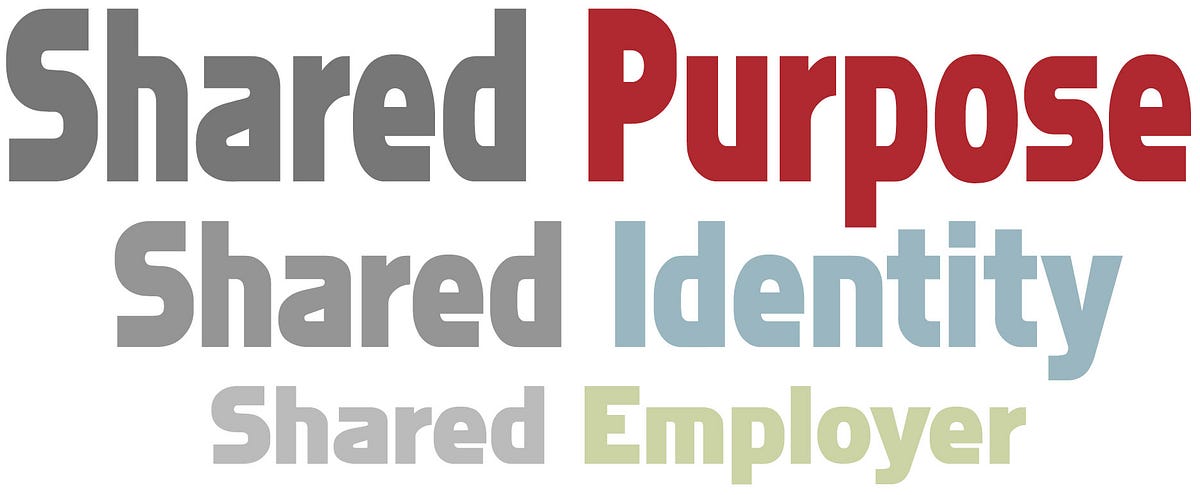
Shared Employer
In shared employer culture, we all just happen to work for that same organization. We don’t feel particularly connected to the company, our coworkers, or what we do. We’re essentially playing on a golf team — individually we play our game and then add up our separate scores at the end of the day to see how the team performed. Shared employer culture doesn’t change the world.
Shared Identity
The next level up is Shared Identity culture. For the most part in shared identity, we like where we work, the people we work with, and the work we do. We run 5Ks together, go out for drinks, and share common interests like the same books, hobbies, and the latest binge watching obsession.
Shared identity culture is an enviable thing, especially if you currently have a Shared Employer culture. People like each other, have a faster uptick as a team, and a shorthand because they have shared experiences and similar backgrounds. But shared identity only gets us so far. There’s another level up that becomes increasingly elusive to achieve the longer we stay at Shared Identity.
There’s also a significant danger with shared identity culture. That danger is that our sense of relatedness and connection to each other cannot only be damaging to our professional growth and personal well-being, but we become resistant to change because of the status quo’s powerful gravitational pull. We become resistant and less than welcoming to people and ideas that don’t quickly mesh with our experience and perspective.
Shared identity culture has another big trait that makes it difficult to change the world: it’s inward looking… us, we, me.
Research shows the more diverse teams and organizations are, the higher performing they can be. With shared identity we struggle to diversify our teams because of that inward focus. It changes our identify, and that leaves us struggling to level up. But for those who can confront this challenge, there’s something special waiting for you…
Shared purpose
Shared purpose culture is change-the-world level shit; for better or worse. In a shared purpose culture people are focused on, and aligned around, the organization’s vision. A vision that’s externally focused, outwardly directed, and therein lies the magic.
How do you build a shared purpose culture? First, figure out what your organization’s purpose is — your purpose, not your mission, they’re different. Your vision answers the question, “Why do you exist as a company,” Your mission answers the question, “What do we do?”
Once you figure out your purpose then run everything — activities, decisions, hiring — through that gauntlet. This takes intent until it becomes second nature.
What you’ll see in practice is not everyone aligns through shared purpose. Some people move no further than shared identity, and still a few others only see shared employer.
Our job as leaders is to manage an inverse pyramid. Get the most number of people in the shared purpose group, followed by fewer people in shared identity, and then fewer people still — hopefully as close to zero as possible — in the shared employer group. And over time, as your shared purpose culture becomes stronger and more ingrained, those in the other buckets start to opt out of your organization.
For more about how you can start creating a Shared Purpose culture, here’s a moving picture primer:
Thanks for watching!
Tim Cynova is a leader, HR consultant, and educator dedicated to co-creating anti-racist and anti-oppressive workplaces through using human-centered organizational design. He is a certified Senior Professional in HR, trained mediator, principal at Work. Shouldn’t. Suck., on faculty at New York’s The New School and Canada’s Banff Centre for Arts and Creativity, and for the past twelve years served as COO and then Co-CEO of the largest association of artists, creatives, and makers in the U.S.
Would you rather be right or effective?
By: Tim Cynova // Published: May 2, 2017
I used to work with someone who would always ask “Which would you rather” questions. Which would you rather: Wear a bathing suit in Antarctica, or a snow suit in the desert? Which would you rather as a musician: Be a one-hit wonder with a song that defines summer for a generation, or a member of a band with modest success for 10 years?
Since those days, I’ve always had a soft spot in my heart for “Which would you rather” questions. In the latest episode of How We Work, we explore “Which would you rather, be right or effective?” in the context of an abrasive leader about to lose their job.
We take a look at self-described Wrongologist Kathryn Schultz and what it feels like when you’re wrong, as well as a retired Brigadier General who literally wrote the book on leading in extreme situations.
And before you say it, yes, sure, there is a way to be both right and effective. However, we’ll use this false dichotomy to look at instances when one’s desire to be right undermines their ability to be effective.
Tim Cynova is a leader, HR consultant, and educator dedicated to co-creating anti-racist and anti-oppressive workplaces through using human-centered organizational design. He is a certified Senior Professional in HR, trained mediator, principal at Work. Shouldn’t. Suck., on faculty at New York’s The New School and Canada’s Banff Centre for Arts and Creativity, and for the past twelve years served as COO and then Co-CEO of the largest association of artists, creatives, and makers in the U.S.


